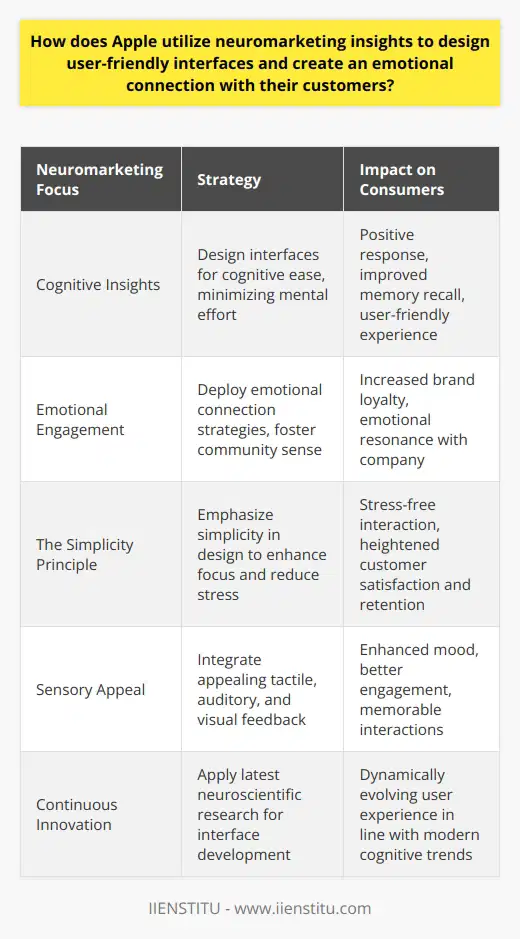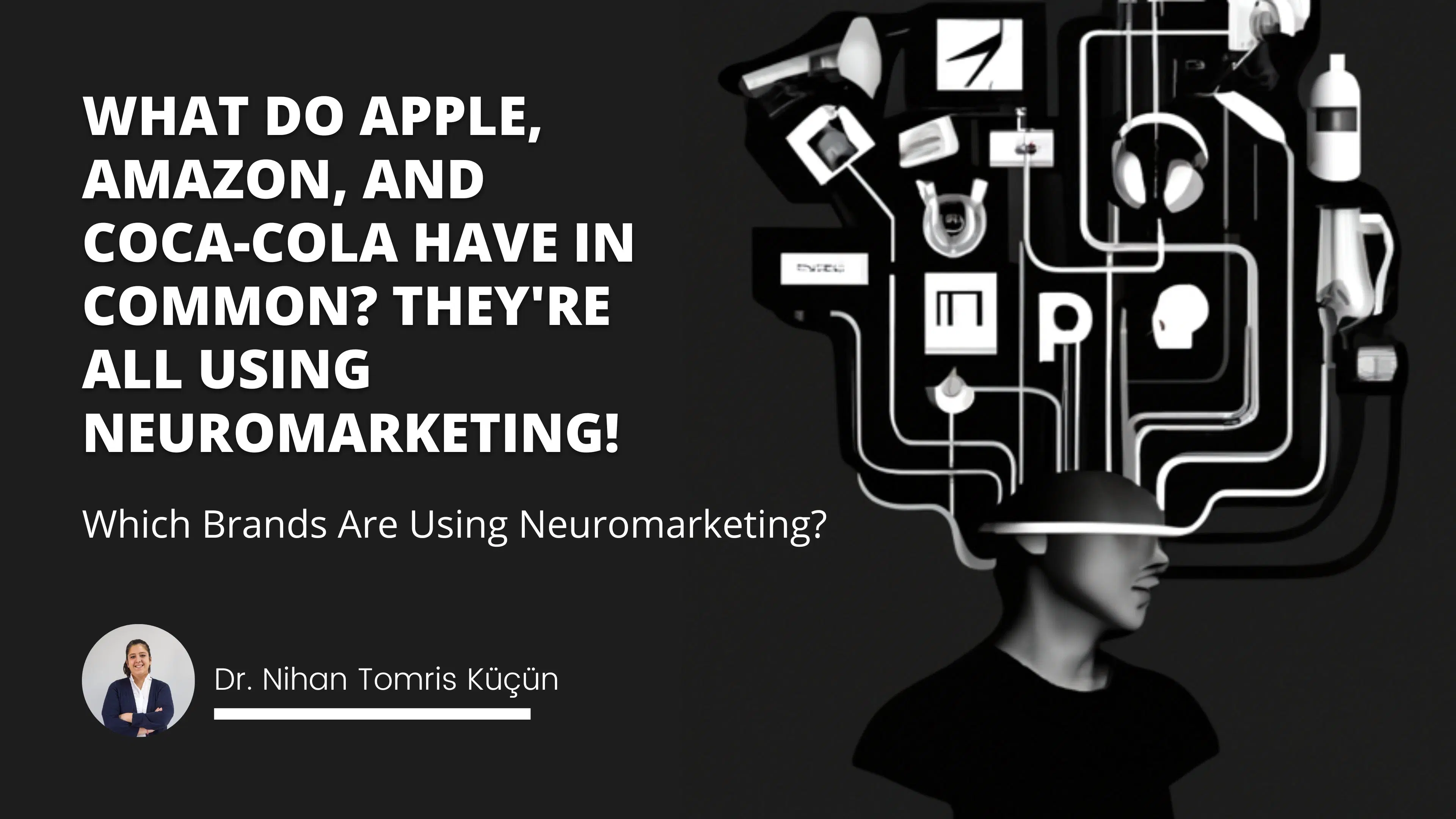
Neuromarketing is a relatively new field of marketing that uses neuroscience to understand consumer behavior. Using techniques such as eye tracking, facial recognition, and EEG scans, neuromarketing helps brands gain valuable insights into how people think, feel and make decisions when purchasing products or services. With this data, companies can tailor their marketing strategies for maximum impact.
In recent years, more and more brands have been turning to neuromarketing to understand their target audiences better and develop effective campaigns. From fashion retailers to food manufacturers, businesses across industries are leveraging the power of neuroscience-based research methods to uncover hidden customer motivations and create personalized experiences that drive sales.
In this article, we'll look at some examples of successful neuromarketing campaigns from well-known brands worldwide and discuss what the future holds for this rapidly growing field.
What is neuromarketing, and how does it work
Neuromarketing is a cutting-edge field of marketing that uses neuroscience to study consumer behavior. This form of marketing relies on the latest advances in neuroscience, such as brain imaging, eye tracking, and facial recognition technology, to gain insights into how people think and make decisions when buying goods and services. It also seeks to uncover hidden motivations that can help brands better connect with their target audience.

The primary purpose of neuromarketing is to understand the relationship between consumers and brands - specifically, why consumers are drawn to certain products or services over others. To do this, neuro marketers use a range of research methods such as EEG scans (to measure electrical activity in the brain), eye tracking (to assess visual attention), and facial recognition software (to analyze emotional responses). By collecting data from these experiments and analyzing it with sophisticated algorithms, neuro marketers can gain valuable insights into how customers interact with brands.
These insights can inform and shape marketing strategies to maximize their impact on sales. For example, through neuromarketing, companies can tailor their campaigns according to individual customer needs or preferences by offering customized experiences—allowing them to stand out in a crowded marketplace.
They can also create campaigns that are more likely to engage customers and drive sales through personalization tactics such as personalized emails or targeted advertisements.
Furthermore, neuromarketing can also be used for product development purposes—helping brands design products that meet customer needs more effectively by using feedback from target audiences early in the process. Using neuromarketing techniques, companies can also modify existing products based on customer feedback captured during experiments.

Finally, neuromarketing can provide invaluable insights into general trends in consumer behavior—such as changes in tastes or shifts towards certain types of products—which can help businesses identify opportunities for growth within their target markets.
Overall, neuromarketing has excellent potential for helping companies build strong relationships with their customers while increasing sales and driving profits. By leveraging the power of neuroscience-based research methods, brands have access to an unprecedented level of insight into how people think, feel, and make decisions when it comes to purchasing items—allowing them to craft more effective campaigns that capture the attention of their target audience while delivering maximum results for minimal cost.
How brands are using neuromarketing to understand consumer behavior
Neuromarketing is a rapidly emerging field that has the potential to revolutionize how brands understand and engage with customers. The use of neuroscience-based research methods can provide invaluable insights into consumer behavior, allowing businesses to design more effective marketing campaigns that capture the attention of their target audience while delivering maximum results for minimal cost.
At its core, neuromarketing is about understanding human behavior on a deeper level. It looks at how people think and make decisions when purchasing goods or services and seeks to uncover hidden motivations that can help brands better connect with their target audience.
To do this, neuro marketers rely on a range of research methods such as EEG scans (to measure electrical activity in the brain), eye tracking (to assess visual attention), and facial recognition software (to analyze emotional responses). By collecting data from these experiments and analyzing it with sophisticated algorithms, neuro marketers can gain valuable insights into how customers interact with brands and what makes them tick.

Brands can use these insights to inform their marketing strategies to maximize their impact on sales. For example, through neuromarketing, companies can tailor their campaigns according to individual customer needs or preferences—allowing them to stand out in a crowded marketplace and create truly personalized experiences that capture the attention of their target audience.
They can also use data collected through neuromarketing experiments to adjust existing products based on customer feedback or develop new ones that are more likely to succeed in the marketplace.
Furthermore, neuromarketing can also provide invaluable insights into general trends in consumer behavior—such as changes in tastes or shifts towards certain types of products—which can help businesses identify opportunities for growth within their target markets and stay ahead of competitors.
In addition, this information allows them to adjust their strategies accordingly to capitalize on changing customer preferences. Finally, neuromarketing techniques can even be used by companies to gain a better understanding of why people choose one product over another—allowing them to design unique campaigns that resonate with consumers more effectively than ever.
The potential benefits of using neuromarketing for brands are clear—it helps reduce costs while increasing ROI by targeting customers who are already interested in what they offer. Moreover, since it relies on neuroscience-based research methods, it provides an unprecedented level of insight into customer behavior, allowing businesses to create campaigns tailored specifically for each type of customer—resulting in far higher conversion rates than would otherwise be possible using traditional marketing tactics alone.
Additionally, taking advantage of this technology also enables organizations to build strong relationships with their customers by offering customized experiences designed specifically for each individual's needs and preferences—ultimately leading to increased loyalty and long-term success for any brand that embraces this powerful form of marketing technology.
In conclusion, there is no denying the potential benefits of neuromarketing when it comes to understanding consumer behavior more effectively than ever before while creating highly targeted campaigns explicitly tailored to your target audience'saudience's interests and needs. Furthermore, by leveraging this cutting-edge technology, companies have access to an unprecedented level of insight into how people think, feel & make decisions when buying items — all of which leads not only to greater efficiency but also higher returns for any business smart enough to seize upon this opportunity now available at our fingertips.
The benefits of using neuromarketing for brands
Neuromarketing is quickly becoming one of the most popular forms of marketing in today'stoday's digital world. Using neuroscience-based research methods, brands can gain valuable insights into how customers interact with their products and what makes them tick.
This allows businesses to tailor their campaigns according to individual customer needs or preferences—creating a more personalized experience that captures the attention of their target audience, resulting in increased sales and more significant ROI.
At its core, neuromarketing involves collecting data from experiments such as EEG scans (to measure electrical activity in the brain), eye tracking (to assess visual attention), and facial recognition software (to analyze emotional responses). By analyzing this data with sophisticated algorithms, businesses gain an unprecedented level of insight into customer behavior—helping them understand why people make certain decisions when buying items and which products or services are more likely to be successful on the market.
Using this information, brands can adjust their marketing strategies accordingly to maximize their impact on sales. This includes understanding changes in tastes or shifts towards certain products within target markets and creating campaigns explicitly tailored for every kind of customer—resulting in far higher conversion rates than would otherwise be possible using traditional marketing tactics alone.
Additionally, leveraging this technology also enables companies to build strong relationships with their customers by offering customized experiences designed specifically for each individual's needs and preferences—ultimately leading to increased loyalty and long-term success for any brand that embraces this powerful form of marketing technology.
Moreover, neuromarketing can also help organizations save significant money through cost reduction. This is due to its ability to identify which ads resonate most with viewers—allowing companies to eliminate those that are less successful or inefficiently targeted, resulting in decreased advertising costs overall.
Furthermore, its precise nature will enable businesses to focus their resources on audiences who are already interested in what they have to offer—leading to greater efficiency and higher returns for any business smart enough to seize upon this opportunity now available at our fingertips.
In conclusion, neuromarketing has revolutionized the way marketers understand consumer behavior by giving them unprecedented insight into how people think, feel & make decisions when buying items. While it may take some time for organizations to adjust their strategy accordingly & fully reap all its benefits — there is no denying that brands that have chosen to embrace this powerful form of marketing techniques have seen significant returns & will continue to see even greater ones down the road ahead.
Case studies of brands that have used neuromarketing successfully.
Neuromarketing is a revolutionary form of marketing that uses neuroscience-based research methods to gain valuable insights into how customers interact with products and brands. By leveraging this technology, businesses can tailor their campaigns according to individual customer needs or preferences—creating a more personalized experience that captures the attention of their target audience, resulting in increased sales and more significant ROI. In addition, neuromarketing also helps organizations save considerable money through cost reduction by identifying which ads resonate most with viewers and eliminating those that are less successful or inefficiently targeted.
Neuromarketing has become an increasingly popular and effective way for companies to gain insights into how customers interact with their products or services. By studying participants' brain activity as they view ads, brands can identify which messages and visuals are most successful and tailor their campaigns accordingly.
This approach enables businesses to create more personalized experiences and increase the likelihood that their message resonates with consumers.
Coca-Cola is one of the most successful examples of a brand leveraging neuromarketing effectively. In 2009, Coca-Cola was looking to create a global advertising campaign that would capture people'speople's attention and happiness, so they used functional MRI and EEG scans to study viewers' brain activity while watching ads. The results showed that the ads successfully elicited positive emotions and increased brand affinity. This campaign ultimately helped Coca-Cola become one of the world's leading soda producers.
Another company that has utilized neuromarketing successfully is PepsiCo. In 2010, PepsiCo conducted a neuromarketing study to compare the brain responses of people who drank Pepsi and those who drank Coke. The results showed that people who drank Pepsi had a higher level of activity in the pleasure centers of their brains than those who drank Coke—leading PepsiCo to reposition itself as "the choice of a new generation" with its advertising campaigns.
BMW is another excellent example of a brand using neuromarketing successfully for product design optimization. In 2012, BMW conducted a study to understand how people react to different car designs using EEG scans, which found that people had a stronger emotional reaction to cars with curved lines than those with straight lines. Based on these findings, BMW designed a new car model—the 3 Series—with curved lines and contours, which was very successful in the marketplace due to its improved aesthetic appeal and superior performance capabilities compared to previous models.
Similarly, Audi also used neuromarketing for product design optimization when creating their A4 model in 2013—utilizing EEG scans to understand how people react emotionally to different designs, finding that curved lines evoked stronger emotional reactions than straight lines did. As such, Audi incorporated curved lines into its A4 model design—which proved incredibly successful with consumers due to its sleek appearance and superior performance capabilities compared to previous models from Audi or other competitors in its segment.
Finally, Apple is another company that has implemented neuromarketing successfully in their product design process over time—conducting various studies utilizing EEG scans throughout 2014 through 2015, which revealed that curvilinear designs elicited more excellent emotional reactions from consumers than linear designs did, leading Apple'sApple's product line with products featuring curvaceous lines such as the iPhone 6S or MacBook Pro Retina display – both being very successful releases from Apple Inc.
As evidenced by these case studies alone, it can be easily seen how companies have leveraged neuromarketing successfully for various purposes, such as creating global campaigns tailored towards individual needs (i.e., Coca-Cola'sCoca-Cola's "Open Happiness" campaign) or improving product design aesthetics (i.e., BMW & Audi'sAudi's use of curved lines).
Moreover, this powerful tool has increased significantly over recent years due to both cheaper research methods available (such as low-cost eye tracking technology) coupled with greater access & availability through cloud computing technology, allowing even smaller organizations access resources previously only available by large-scale enterprises – making it easier than ever before for companies utilize this tool in order optimize customer experience & increase ROI on marketing investments alike – all while providing valuable insights into consumer behavior & preferences which can help shape future decisions & strategies amongst organizational stakeholders in the future.
Neuromarketing has quickly become one of the most popular tools for brands to gain an understanding of their target audience and their preferences. It offers new ways to measure consumer behavior and understand how people interact with various products, services, and marketing campaigns. Additionally, it is a powerful tool that can be used to improve product design, increase brand loyalty and affinity, and optimize the customer experience.
With the continued advances in technology, neuromarketing will only become more accessible and valuable over time – ultimately leading to greater insight into consumer behavior and making it easier for businesses to make informed decisions with data-driven strategies.
As technology continues to evolve rapidly, so too does neuromarketing—with access becoming more accessible than ever due to low-cost eye-tracking technology coupled with cloud computing providing greater access & availability than ever before.
This method of research has helped many large-scale companies gain insight into consumer behavior & preferences through various studies utilizing EEG scans which revealed that curvilinear designs often elicited stronger emotional reactions from consumers than linear designs did, leading many companies such as BMW & Audi incorporate more curved lines into product design aesthetics across their product lines & improving overall customer experience as a result.
However, smaller organizations are now beginning to leverage this powerful tool to optimize customer experience & increase ROI on marketing investments alike – all while providing valuable insights into consumer behavior & preferences, which can help shape future decisions & strategies amongst organizational stakeholders.
The future of neuromarketing and its impact on the marketing industry
The future of neuromarketing looks increasingly promising as the technology becomes more accessible — providing businesses with an invaluable resource through which they can accurately understand their customers' wants, needs, and reactions without any bias or prejudice being introduced by traditional market research methods such as surveys or focus groups.
For example, neuromarketing can provide brands with real-time information regarding how people interact with their products—allowing them to identify any potential issues or problems before they arise in the marketplace and make any necessary improvements to ensure customer satisfaction is maintained at high levels moving forward.
Additionally, it allows marketers to create personalized campaigns explicitly tailored toward individual needs – helping them build relationships with customers on a deeper level & generate greater brand loyalty.
Moreover, neuromarketing is also predicted to significantly impact the marketing industry regarding pricing strategies—providing valuable insight into how much consumers are willing to pay for certain products based on perceived value or need for convenience.
Currently, this kind of data is difficult (if not impossible) for marketers to obtain through traditional market research methods; however, companies that utilize advanced analysis techniques such as machine learning can harness the power of big data to determine pricing levels that will maximize revenue while also ensuring customers remain satisfied with their purchase decision going forward.
In conclusion, although neuromarketing is still relatively new within the marketing industry—its popularity has been steadily increasing over recent years due to both cheaper research methods available coupled with greater access & availability through cloud computing technology, allowing even smaller organizations access resources previously only available by large scale enterprises.
As technology continues this evolution at an exponential rate in years ahead, so will its application within business contexts, ultimately revolutionizing customer experience management & enabling marketers to reach new heights of success never dreamed possible just decades ago!

Frequently Asked Questions
What are the benefits of using neuromarketing for brands?
The main benefit of using neuromarketing for brands is that it provides them with invaluable insight into consumer behavior and preferences without any bias or prejudice introduced by traditional market research methods such as surveys or focus groups. Additionally, it allows marketers to create personalized campaigns explicitly tailored toward individual needs – helping them build relationships with customers on a deeper level and create greater brand loyalty in the process. Finally, neuromarketing can also provide valuable data regarding pricing strategies – allowing companies to determine classes that will maximize revenue while still ensuring customer satisfaction.
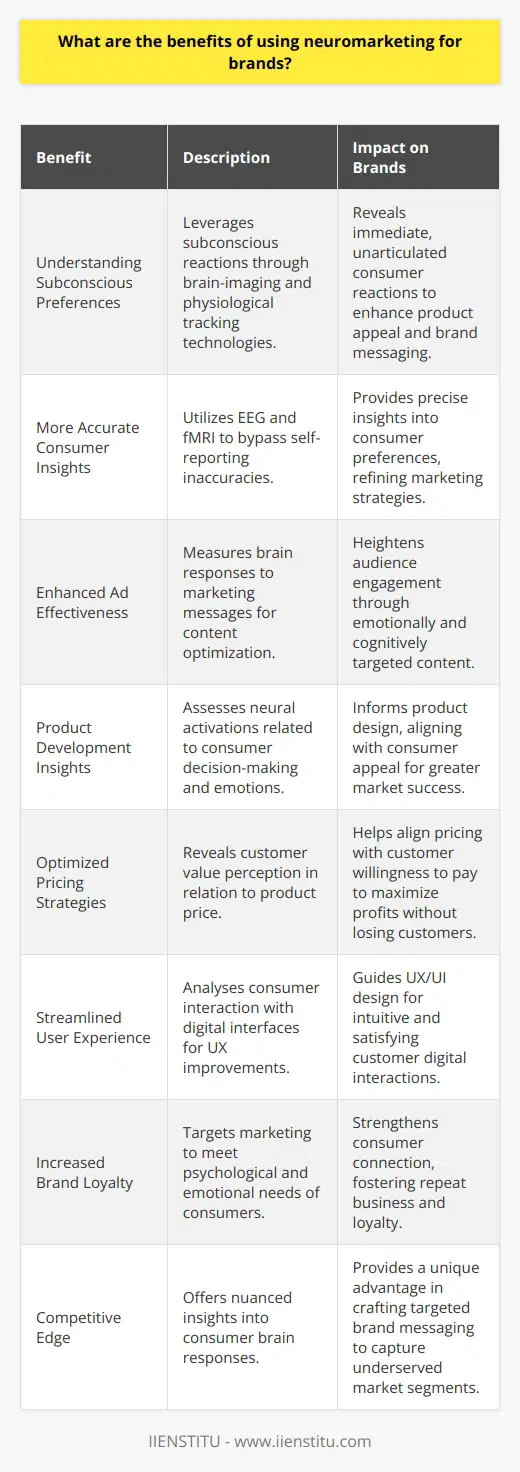
What is the potential of neuromarketing to shape future decisions and strategies amongst organizational stakeholders?
Neuromarketing holds great potential to shape future decisions and strategies among organizational stakeholders. The technology provides businesses with an invaluable resource through which they can accurately understand their customers' wants, needs, and reactions without any bias or prejudice introduced by traditional market research methods such as surveys or focus groups. Additionally, it allows marketers to create personalized campaigns explicitly tailored toward individual needs – helping them build relationships with customers on a deeper level & generate greater brand loyalty. Furthermore, neuromarketing can also provide valuable data regarding pricing strategies—providing organizations with intelligence that will enable them to maximize revenue while ensuring customer satisfaction. Ultimately, this kind of data allows brands to make informed decisions backed up by real-world evidence rather than relying purely on assumptions, thereby positioning themselves better against competitors within crowded markets & ultimately increasing profits in the long run!
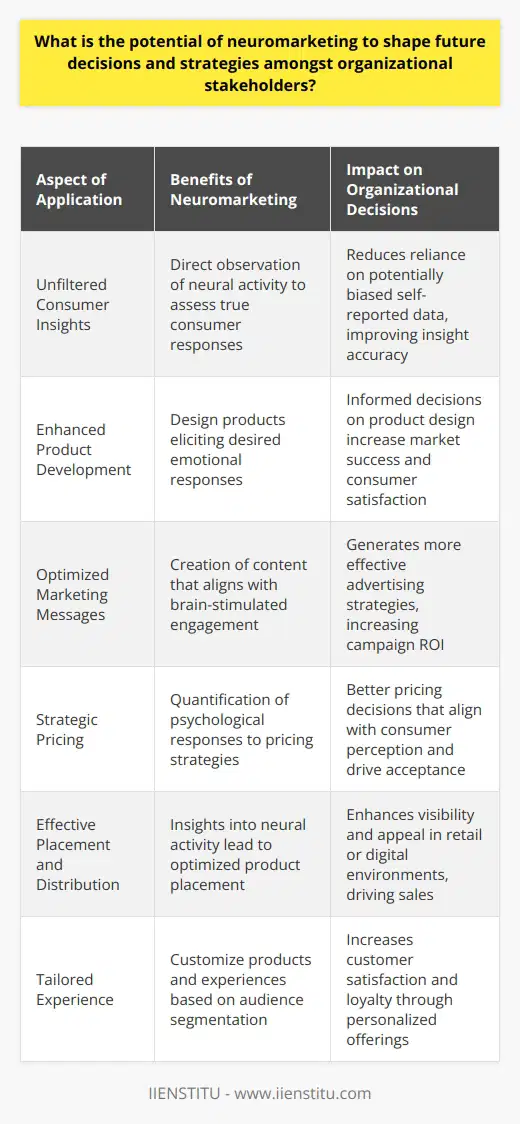
What is the potential of neuromarketing to improve customer experience management?
Neuromarketing has excellent potential for improving customer experience management. Using advanced analysis techniques such as machine learning, companies can acquire valuable insights into consumer behavior and preferences without any bias or prejudice introduced by traditional market research methods. Additionally, it allows marketers to create personalized campaigns explicitly tailored toward individual needs – helping them build relationships with customers on a deeper level & generate greater brand loyalty. Furthermore, neuromarketing can also provide valuable data regarding pricing strategies—providing organizations with intelligence that will enable them to maximize revenue while ensuring customer satisfaction. Ultimately, this kind of data allows brands to make informed decisions backed up by real-world evidence rather than relying purely on assumptions, thereby positioning themselves better against competitors within crowded markets & ultimately increasing profits in the long run!
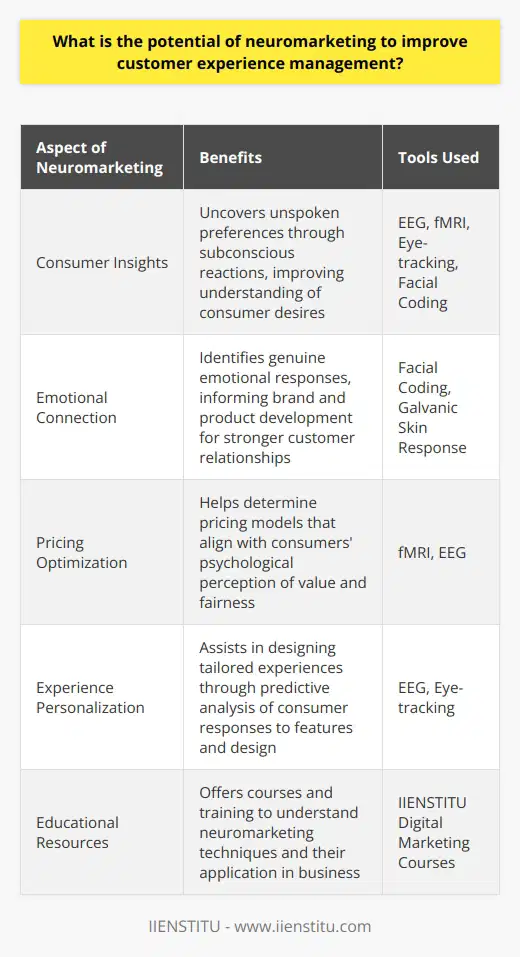
What are neuromarketing's future and its impact on the marketing industry?
The future of neuromarketing is auspicious for marketers and consumers. As more companies realize the potential benefits it can bring to their operations, the technology will become increasingly prevalent within the marketing sector—allowing brands to gain a greater understanding of consumer behavior to provide them with tailored experiences & services. Furthermore, this level of personalization could potentially lead to an overall improvement in customer experience management; thereby helping businesses build stronger relationships with their customers while also increasing loyalty & revenue as a result. Ultimately though, only time will tell exactly how neuromarketing will shape up but given its current trajectory – it'sit's safe to say that its impact on the marketing industry won'twon't be anything short of revolutionary.
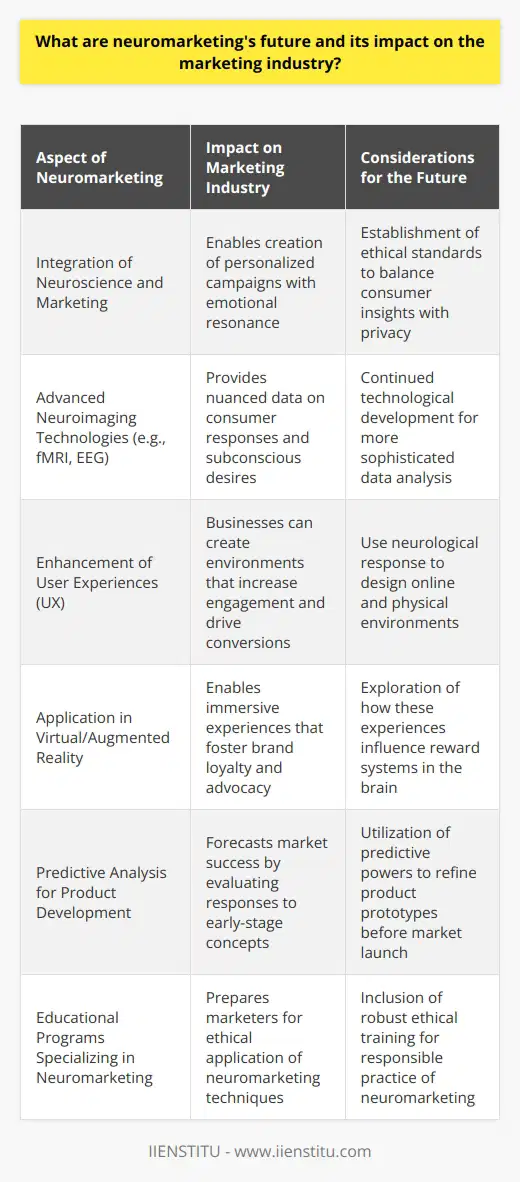
What is the potential of neuromarketing to improve customer experience management?
Neuromarketing has excellent potential for improving customer experience management. Using advanced analysis techniques such as machine learning, companies can acquire valuable insights into consumer behavior and preferences without any bias or prejudice introduced by traditional market research methods. Additionally, it allows marketers to create personalized campaigns explicitly tailored toward individual needs – helping them build relationships with customers on a deeper level & generate greater brand loyalty. Furthermore, neuromarketing can also provide valuable data regarding pricing strategies—providing organizations with intelligence that will enable them to maximize revenue while ensuring customer satisfaction. Ultimately, this kind of data allows brands to make informed decisions backed up by real-world evidence rather than relying purely on assumptions, thereby positioning themselves better against competitors within crowded markets & ultimately increasing profits in the long run!

What implications do neuromarketing data have for marketing decisions?
Neuromarketing data has the potential to provide a much more comprehensive and accurate picture of consumer behavior than traditional market research methods. This allows organizations to make more informed decisions based on real-world evidence rather than relying purely on theoretical assumptions. For example, through neuromarketing, brands can gain insight into how customers perceive their products & services and what motivates them to purchase specific items or services over others. This analysis can also inform pricing strategies—allowing companies to maximize revenue while ensuring customer satisfaction. Ultimately, neuromarketing will enable marketers to craft campaigns explicitly tailored towards individual needs – helping them create relationships with consumers on a deeper level & build greater brand loyalty in the process, transforming their operations in the long run!
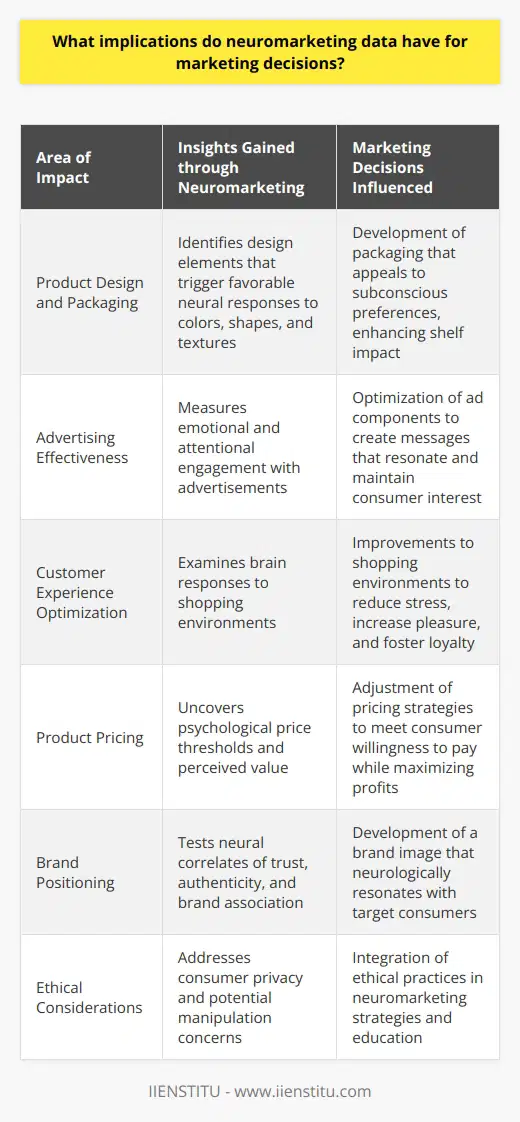
How does Coca Cola use neuromarketing to influence purchasing decisions?
Neuromarketing Techniques Employed by Coca Cola
Coca Cola leverages neuromarketing to influence consumers' purchasing choices by employing various strategies. These approaches typically target consumers' subconscious, thereby triggering desired behaviors without them realizing it. One such technique is the use of emotionally appealing advertising content, which stimulates consumers' brains to associate Coca Cola products with positive emotions.
Emotional Advertising
In many of its ads, Coca Cola utilizes heartwarming scenes and inspiring stories to engage viewers on an emotional level. This approach often works because the brain reacts more strongly to emotions than to facts, making such content more memorable and effective. Consequently, when viewers see a Coca Cola product, they are more likely to recall the emotions triggered by the advert, subsequently influencing their decision to purchase the product.
Color and Logo Associations
Another aspect of Coca Cola's neuromarketing strategy is the use of consistent color and logo schemes. The iconic red and white colors, paired with the unique cursive font of the company's logo, contribute to strong brand recognition. As a result, consumers form a mental association between the color scheme and the brand, which in turn triggers a subconscious desire to purchase the product upon encountering these visual stimuli.
Taste Perception
Coca Cola also employs neuromarketing techniques in relation to taste perception. By promoting the idea that their beverage has a unique and incomparable flavor, the company creates an expectation in consumers' minds. In turn, this expectation influences the actual taste sensation experienced by consumers, due to the strong connection between the brain's taste receptors and the way it processes sensory information.
Sensory Integration
The sensory integration strategy is another key aspect of Coca Cola's neuromarketing. This approach involves appealing to multiple senses simultaneously, creating a richer and more persuasive experience for consumers. For instance, Coca Cola's ads may feature the sound of a fizzing beverage, the sight of condensation on a cold bottle, and the satisfying crack of the bottle being opened. By stimulating multiple senses, the brand creates a more immersive and enticing experience, ultimately making it more likely that consumers will choose Coca Cola products over competitors.
In conclusion, Coca Cola employs various neuromarketing techniques to influence consumers' purchasing decisions. By leveraging emotional advertising, color and logo associations, taste perception, and sensory integration, the company effectively impacts the subconscious minds of consumers, encouraging their preference for Coca Cola products.
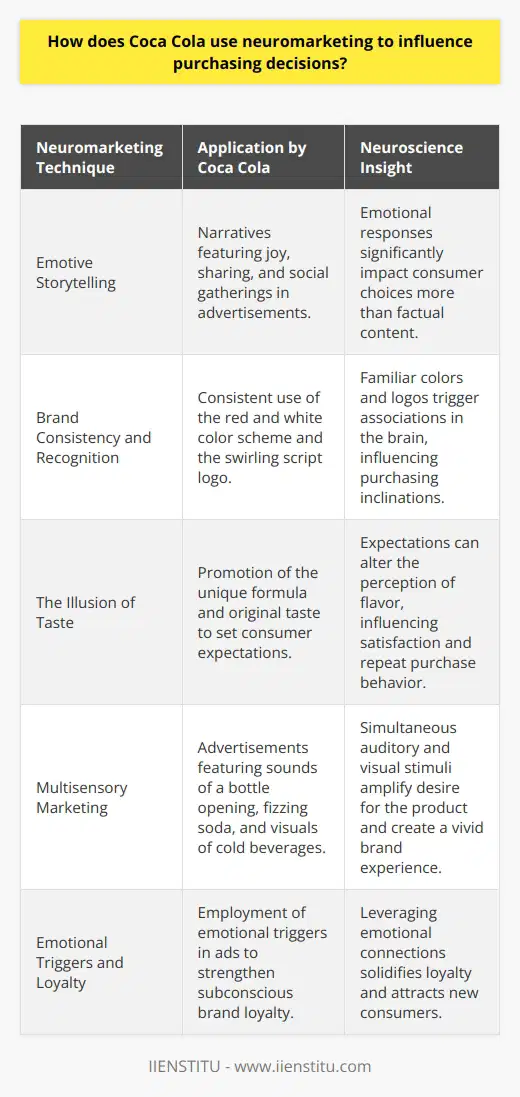
In what ways does Disney implement neuromarketing techniques to enhance visitor experiences?
Neuromarketing Techniques Leveraged by Disney
Disney has long been a pioneer in crafting compelling and immersive experiences, and neuromarketing plays a significant role in these efforts. By drawing on an understanding of the human brain and cognition, Disney tailors its strategies to stimulate emotional responses that optimize visitor engagement.
Utilization of Multisensory Stimulation
Disney's theme parks exemplify the comprehensive use of multisensory stimulation. Auditory, olfactory, and tactile stimulation transport visitors into a fantasy world, triggering their imagination and fostering emotional connections. For instance, the use of scents like freshly baking cookies can evoke positive memories and create a sense of nostalgia, heightening the overall emotional impact of the experience.
Storytelling as a Central Element
Disney is renowned for its storytelling prowess, and it is an essential ingredient in their neuromarketing approach. By carefully crafting narratives and relatable characters, they tap into the power of empathy and identification, allowing visitors to forge deep emotional connections with these stories. In doing so, they create memorable experiences that resonate strongly and leave a lasting impression on the visitors.
Designing for Emotional Resonance
Through the meticulous design of rides, attractions, and environments, Disney effectively taps into emotions that drive human behavior. By utilizing principles of cognitive psychology, they consistently evoke feelings of awe, wonder, and delight. For example, the Cinderella Castle, which serves as the centerpiece of the Magic Kingdom, symbolizes the promise of transformation and a happily ever after, arousing hope and anticipation among visitors.
Optimizing Cognitive Flow and Engagement
Disney’s theme parks facilitate an optimal cognitive flow by seamlessly blending various elements into a cohesive experience. They employ intuitive designs that minimize confusion, reduce cognitive load, and promote a sense of exploration. Additionally, strategic placement of 'weenies' – visual magnets – leads visitors through the parks and guides their attention towards key attractions, creating an engaging and seamless journey.
In conclusion, Disney showcases a mastery of neuromarketing techniques by providing multi-sensory stimulation, incorporating captivating storytelling, designing for emotional resonance, and fostering cognitive flow. These strategies help create unforgettable experiences, leaving a lasting impact on visitors and solidifying Disney's status as a leader in crafting immersive and emotionally engaging experiences.
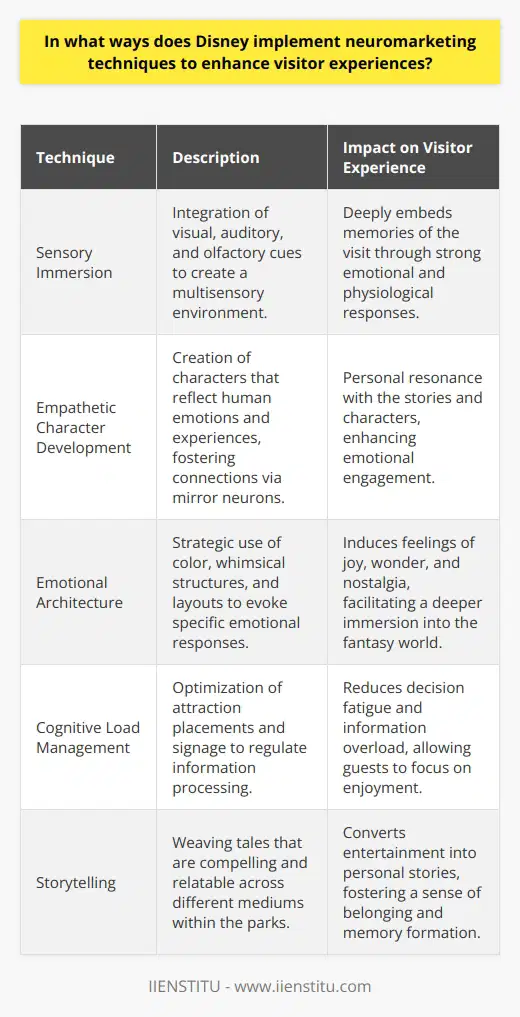
How has Google integrated neuromarketing research into their advertising strategies?
Neuromarketing Research and Google
Understanding Neuromarketing
Neuromarketing is an emerging field of study that combines neuroscience with marketing. Researchers study the brain's responses to different stimuli to understand consumer behaviour and preferences. Google, as a leading technology company, has recognized the potential of neuromarketing research and integrated it into their advertising strategies.
Neural Measures in Advertising
Google uses various neural measures to determine the effectiveness of ads. Electroencephalography (EEG) measures changes in brain activity in response to specific stimuli. Functional magnetic resonance imaging (fMRI) provides insights into the brain's blood flow and neural activity when subjects view ads. Google's advertising team employs these methods to gather valuable information about consumer preferences and improve ad targeting.
Emotions and Decision-making
Emotional reactions play a significant role in influencing consumer decisions, and Google considers this while designing ads. Neuromarketing research has demonstrated that emotions are more effective in guiding consumer behaviour than rational thinking. Thus, Google creates emotionally engaging ads that evoke positive feelings, resulting in higher chances of consumers taking action and advertisers securing a return on investment.
Tailoring Ad Strategies
By integrating neuromarketing research into their advertising strategies, Google is better equipped to interpret consumer preferences and tailor their ads accordingly. Research findings allow Google to segment their audience and design targeted ads for different groups. Such ads cater to the specific needs and preferences of consumers, resulting in maximized efficiency and effectiveness in Google's ads.
The Future of Google's Neuromarketing Endeavours
Moving ahead, Google's relentless pursuit of innovation and excellence in advertising is expected to yield new neuromarketing research techniques. These techniques will offer further insights into consumer behaviour, enabling Google to refine their advertising strategies and maintain their competitive edge. In conclusion, Google's integration of neuromarketing research has significantly enhanced their advertising strategies, ensuring the delivery of engaging and effective ads in line with consumer preferences.
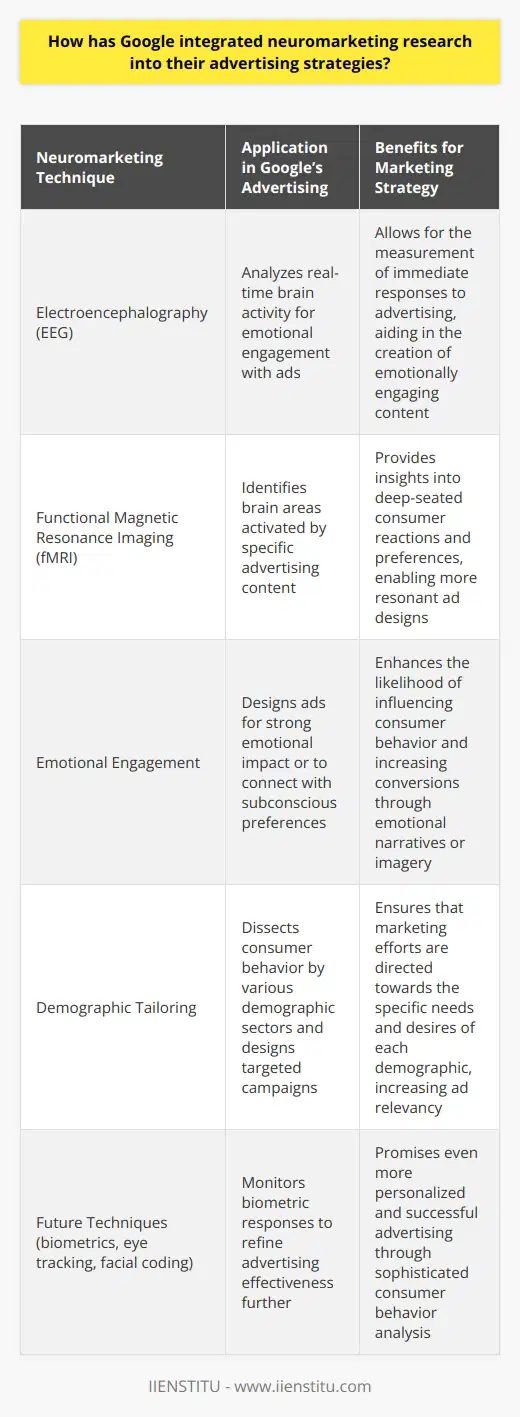
How does neuromarketing inform Google's user experience design process?
Neuromarketing and Google's User Experience Design
Understanding Neuromarketing
Neuromarketing is the study of how consumers respond to marketing stimuli. It uses neuroscience to understand and predict consumer behavior, ensuring the effectiveness of marketing strategies. Researchers gather data through methods such as fMRI, eye-tracking, and EEG to identify how the brain reacts to advertisements or product designs. Google employs neuromarketing to enhance its user experience design, aiming to attract and retain users.
Influence on Google's Design Process
Google utilizes neuromarketing to make data-driven decisions in its design process. By understanding how users react to visuals, colors, and other design elements, Google can optimize the interface for increased user engagement. For example, studies have shown that the human brain prefers visually appealing designs that capture attention. Google's minimalistic yet vibrant design reflects this preference, encouraging users to interact with their platform.
Optimizing Websites and Advertising
Neuromarketing enables Google to create intuitive user interfaces for its websites and advertise effectively. By understanding which design elements engage users, they can simplify website navigation and develop targeted advertisements that resonate with specific audiences. This approach aids in maintaining user satisfaction and promoting repeat visits, as users are more likely to remain engaged with a platform they find aesthetically appealing and easy to navigate.
Innovation and User Satisfaction
Google's integration of neuromarketing into the user experience design process allows for innovation in its products and services. By continually analyzing user feedback and preferences, the company can adapt its interface to meet changing needs. The constant evolution of Google's design helps maintain user satisfaction and loyalty, ensuring the company's longevity in the competitive tech industry.
Conclusion
In conclusion, neuromarketing significantly informs Google's user experience design process. It provides valuable insights into user preferences and behaviors, enabling the optimization of website interfaces and advertisements. The resulting design innovations contribute to increased user satisfaction and brand loyalty, bolstering Google's position in the market.
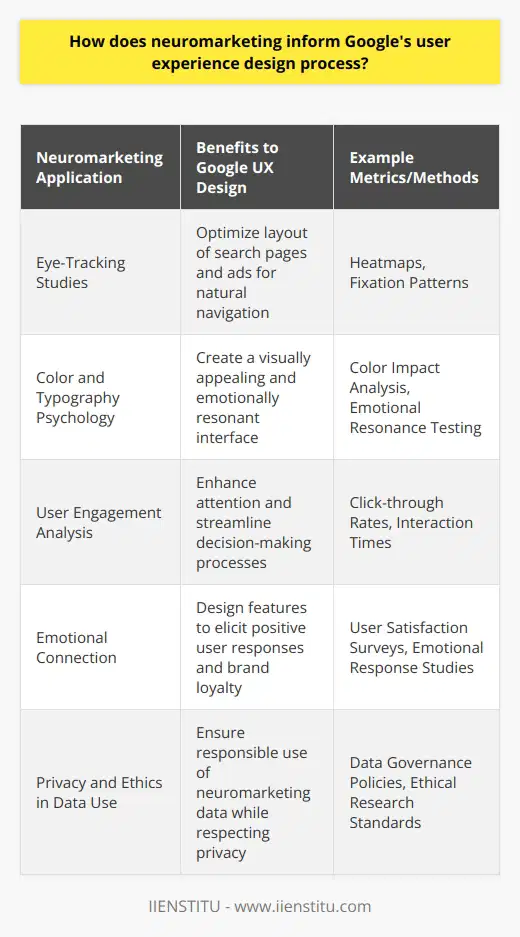
In what ways does Disney leverage neuromarketing insights to optimize their storytelling and content creation?
Neuromarketing in Disney's Content
Understanding Consumer Cognition
Disney effectively employs neuromarketing insights to optimize its storytelling and content creation by exploring consumer cognition. The company gathers valuable consumer data through various means, such as eye-tracking, facial expressions, and electroencephalography (EEG). These methods give Disney invaluable insights into consumer preferences and emotional responses, essential for crafting engaging stories.
Evoking Emotional Engagement
One of the primary applications of neuromarketing in Disney's content creation is evoking emotional engagement through its storytelling techniques. The company focuses on developing characters with universal appeal, allowing consumers to connect with them on an emotional level. Disney's stories often incorporate a strong moral message, aligning with consumers' values and eliciting strong emotional responses, leading to an enhanced viewer experience.
Utilizing the Power of Music
Another critical aspect of Disney's neuromarketing approach is utilizing the power of music to evoke emotions and memories. Music plays an essential role in Disney's storytelling, delivering a multi-sensory experience that resonates with viewers on a subconscious level. By leveraging iconic soundtracks and familiar tunes, Disney elicits emotional responses from its audience, increasing the overall impact of its content.
Appealing to Nostalgia
Disney content creators also recognize the potent influence of nostalgia in capturing audience attention. Familiar stories and characters, often associated with viewers' childhood memories, evoke feelings of warmth, comfort, and familiarity. By reintroducing beloved characters and updating classic storylines, Disney leverages nostalgia's psychological impact to maintain a strong connection with the audience.
Cultivating Curiosity and Surprise
Disney also leverages neuromarketing insights to optimize its content creation by cultivating curiosity and surprise in its stories. The company achieves this by using cliffhanger moments, plot twists, and unexpected character developments that keep viewers engaged and intrigued. This strategy encourages audiences to actively participate in the story, fostering a deeper emotional investment in the content.
Conclusion
In conclusion, Disney's expertise in leveraging neuromarketing insights allows the company to create content that resonates with viewers on a cognitive and emotional level. By combining emotionally engaging storytelling, the power of music, appealing to nostalgia, and cultivating curiosity and surprise, Disney maximizes audience engagement and ensures the continued success of its content.
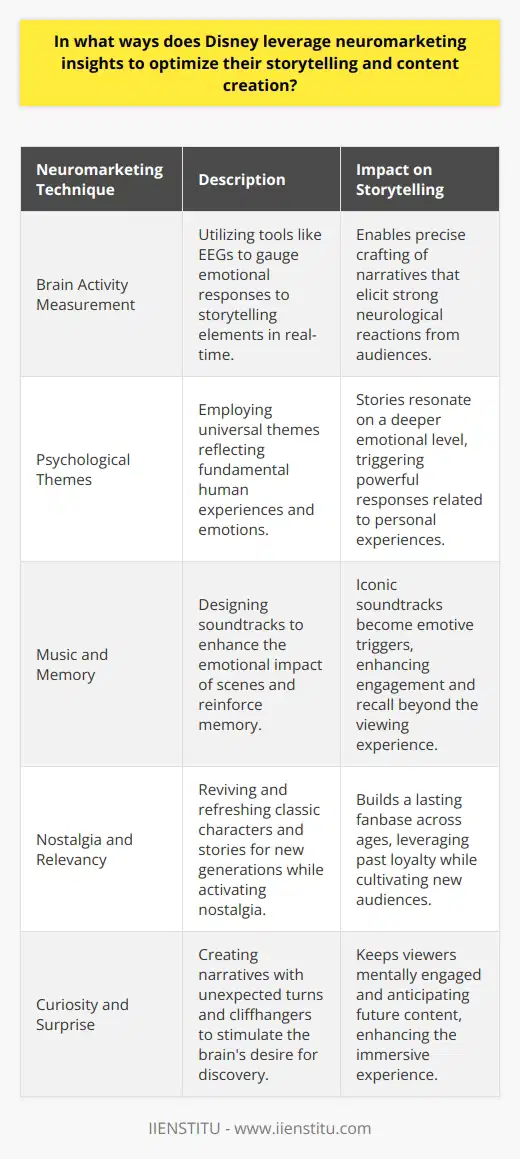
How does Coca Cola's adoption of neuromarketing techniques impact brand perception and consumer behavior?
Neuromarketing Techniques and Brand Perception
Coca Cola's adoption of neuromarketing techniques has had a significant impact on brand perception and consumer behavior. Through the use of neuromarketing tools such as neuroimaging and biometric measuring devices, Coca Cola has been able to gather valuable insights into their customer's emotions, preferences, and decision-making processes. By understanding the neural responses of their target audience, the company has been able to create marketing strategies that effectively influence consumer behavior and enhance brand perception.
Emotional Connection with Consumers
One of the ways in which Coca Cola uses neuromarketing is by evoking emotions in its marketing campaigns. By appealing to the consumer's emotions, the company has managed to create a strong emotional connection between their products and their target audience. The effective use of visual and auditory cues in advertisements triggers positive emotions such as happiness, excitement, and nostalgia, which leads to a favorable perception of the brand and eventually increases product consumption.
Creating Memorable Experiences
Coca Cola has also focused on creating memorable experiences to influence consumer behavior. Neuromarketing techniques have enabled the company to assess and understand the psychological triggers that create lasting memories related to the brand. By leveraging these insights, Coca Cola has developed advertisements and promotional activities that evoke a strong sense of nostalgia and positive associations, which instill brand loyalty and influence future purchasing decisions.
Optimizing Product Placement
Neuromarketing research has also informed the company's product placement strategies both in-store and within digital platforms. By utilizing eye-tracking data, Coca Cola has identified optimal locations that capture consumer attention within retail environments. Furthermore, the use of EEG (electroencephalogram) technology has enabled the company to test and optimize digital advertisements and content placement on various platforms. As a result, Coca Cola has been able to maximize product visibility and drive consumer engagement, which in turn, boosts sales.
Conclusion
In conclusion, the adoption of neuromarketing techniques has allowed Coca Cola to have a greater impact on consumer behavior and enhance brand perception. By understanding and appealing to the emotional and psychological aspects of their audience, the company has been able to create effective marketing strategies that resonate with consumers and influence their decisions. Consequently, neuromarketing has become a valuable tool for Coca Cola in maintaining its position as a leading global brand.
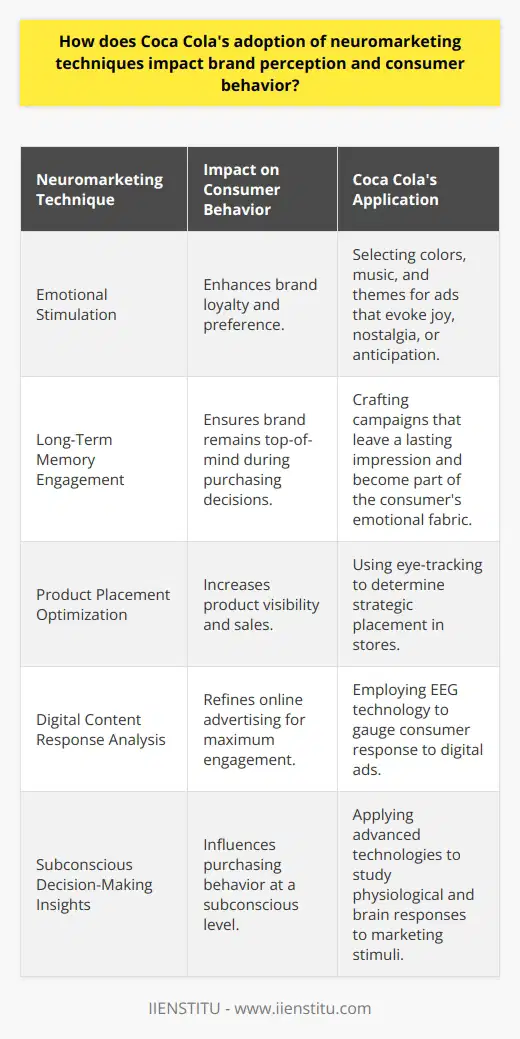
How do neuromarketing strategies employed by Coca Cola enhance product packaging and visual appeal?
Neuromarketing Strategies Employed by Coca-Cola
Understanding Consumer Perception
Neuromarketing strategies employed by Coca-Cola have significantly enhanced their product packaging and visual appeal. By investigating brain responses to different stimuli, Coca-Cola is able to identify unconscious preferences of consumers, enabling them to make more informed decisions in creating packaging that resonates with their target market. Consequently, this approach allows for the development of product designs that captivate the attention of potential buyers and increase the likelihood of purchase.
Color Psychology in Packaging Design
One notable aspect of neuromarketing applied by Coca-Cola is the use of color psychology in their packaging design. Color plays an important role in how individuals perceive and react to products, often invoking emotional associations and subconscious messages. For instance, Coca-Cola's signature red color has been associated with excitement, passion, and energy, which may encourage impulsive buying decisions. Moreover, the consistent use of this hue in both the logo and packaging has established an iconic brand image that is easily recognized by consumers worldwide.
Typography and Layout Techniques
Coca-Cola also considers the impact of typography and layout techniques in their product packaging. Through neuromarketing research, they have discovered that specific fonts and arrangements of design elements can influence consumer perceptions and evoke desired emotional responses. By utilizing clear, legible text and a visually balanced composition, the package design can become more appealing and communicate the intended message effectively, ultimately leading to increased product interest and sales.
Utilizing Emotional Triggers
Coca-Cola's successful fusion of emotional triggers with their product packaging further showcases the influence of neuromarketing in enhancing visual appeal. By understanding the impact of emotions on consumer behavior, Coca-Cola is able to create packaging that evokes positive feelings, such as a sense of nostalgia or happiness. For example, their limited edition packaging features images and designs from various eras, tapping into the sentimental memories and fostering an emotional connection with the brand.
Overall, neuromarketing strategies employed by Coca-Cola have greatly contributed to their ability to create visually appealing product packaging that enhances both consumer perception and brand recognition. By understanding the subconscious influences on consumer behavior, Coca-Cola has developed a powerful marketing approach that effectively captivates the attention of their target audience, resulting in increased product interest and sales.
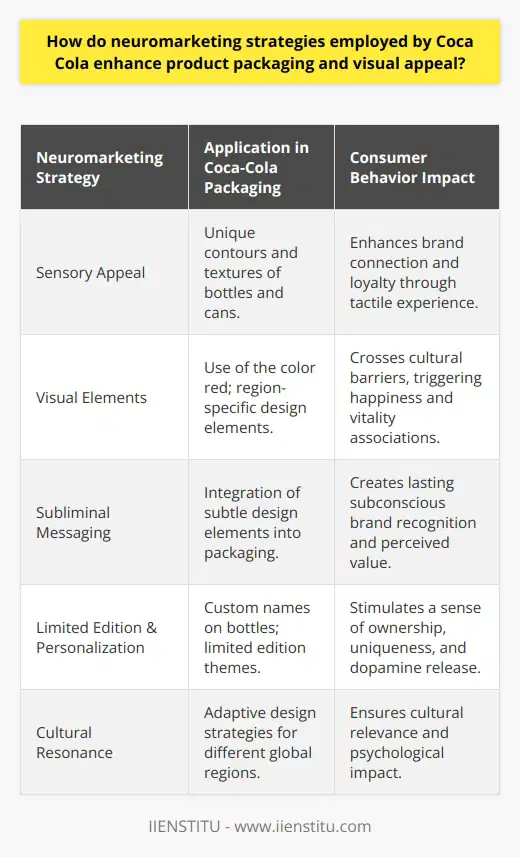
In what ways does Google utilize neuromarketing to create more effective and engaging search results?
Neuromarketing Techniques in Google Search
Google employs neuromarketing methods to optimize its search results and make them more engaging for users. One prominent technique is through eye-tracking studies. Google conducts extensive eye-tracking research to analyze users' eye movement patterns when they interact with search result pages. By monitoring the areas of the page that receive the most attention, Google can determine the most effective layout and content display.
Emotional Response to Search Results
Another essential aspect of neuromarketing is understanding and evoking an emotional response. Google achieves this by incorporating rich content, such as images, videos, and featured snippets, into its search results. By providing information in an attractive and easily digestible format, Google can effectively engage with users and foster a positive emotional connection between them and the platform.
User-Friendly Interface
Google's search interface is designed with usability in mind. Neuromarketing principles suggest that users are more likely to engage with a platform if the experience is seamless and stress-free. Google achieves this by utilizing a clean layout, minimal distractions, and straightforward navigation, making it easy for users to find and access the information they're looking for.
Personalization and Relevance
A key component of neuromarketing is personalization, which involves tailoring content to match individual preferences and behaviors. Google leverages user data, such as search history and demographics, to deliver personalized search results. By presenting users with relevant and tailored content, Google can enhance user engagement and increase the likelihood of users finding the information they seek.
Continuous Testing and Improvement
Finally, Google adopts a data-driven approach to continuously test and improve its search algorithms. This includes running experiments and utilizing user feedback to identify potential improvements. By applying neuromarketing techniques to understand user behavior and preferences, Google can make informed decisions about adjusting its search algorithms and optimizing the overall user experience.
In conclusion, Google's application of neuromarketing techniques contributes to more effective and engaging search results. By focusing on eye-tracking, emotional response, user-friendly design, personalization, and continuous improvement, Google can enhance the search experience in a way that resonates with users and drives engagement.
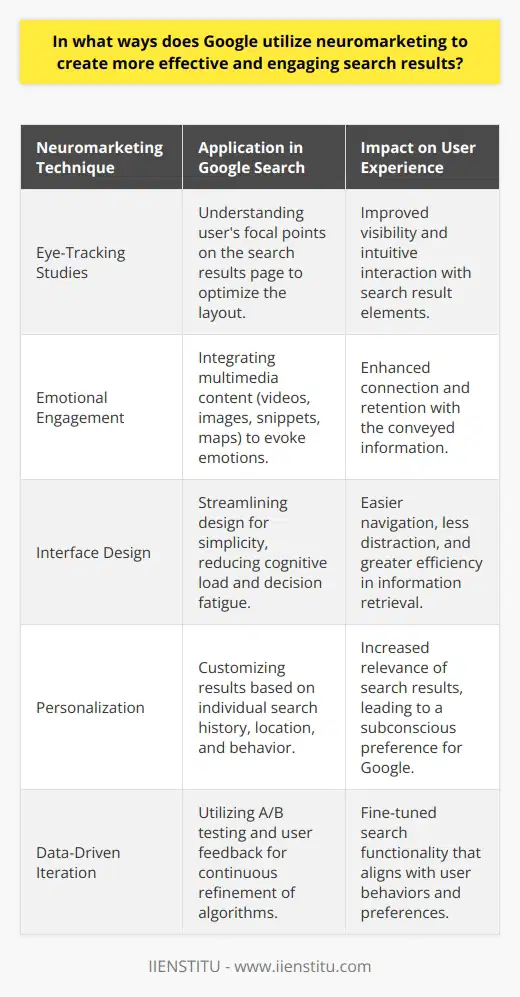
How does Disney's application of neuromarketing principles contribute to the emotional resonance and immersion of their theme park experiences?
Neuromarketing Principles in Disney Theme Parks
Disney's application of neuromarketing principles significantly contributes to the emotional resonance and immersion of their theme park experiences. Neuromarketing revolves around understanding how consumers' brains respond to various marketing stimuli, allowing companies to create more effective promotions and themed environments.
Sensory Engagement
One way Disney employs neuromarketing is by engaging visitors' senses to create an immersive atmosphere. Techniques such as soundscapes, scents, and tactile experiences trigger emotional responses that resonate with guests, heightening their connection to the theme park. For example, the scent of freshly baked cookies or popcorn wafts through the air at various points in the park, invoking feelings of nostalgia, comfort, and joy.
Visual Storytelling
Disney utilizes compelling visual storytelling to further enhance emotional resonance. Attractions are carefully designed to take guests on a journey, with attention to detail in both the ride mechanics and surrounding environment. For instance, the picturesque landscapes, architecture, and intricate designs grab the attention of visitors, making them feel like they have entered a different world.
Emotional Brand Connection
Disney fosters an emotional brand connection through its iconic characters and stories that permeate its theme park experiences. These characters evoke strong emotions, memories, and sentimental attachments, which create an emotional bond between the visitor and the brand. Moreover, this connection extends beyond the theme parks, as guests continue to engage with Disney through merchandise, films, and other media content.
Anticipation and Novelty
Disney's ability to maintain anticipation and introduce novelty in its attractions contributes to its guests' immersive experience. By consistently updating and expanding its offerings, the company stimulates curiosity and excitement among visitors, enticing them to return. New rides and attractions are often revealed with much fanfare, generating buzz and further cementing the emotional connection between the brand and its consumers.
In summary, Disney's skillful application of neuromarketing principles contributes to the emotional resonance and immersion of its theme park experiences. By engaging visitors' senses, utilizing visual storytelling techniques, creating emotional brand connections, and maintaining anticipation and novelty, Disney consistently delivers memorable and captivating moments for guests, resulting in lasting bonds and a unique attachment to the brand.
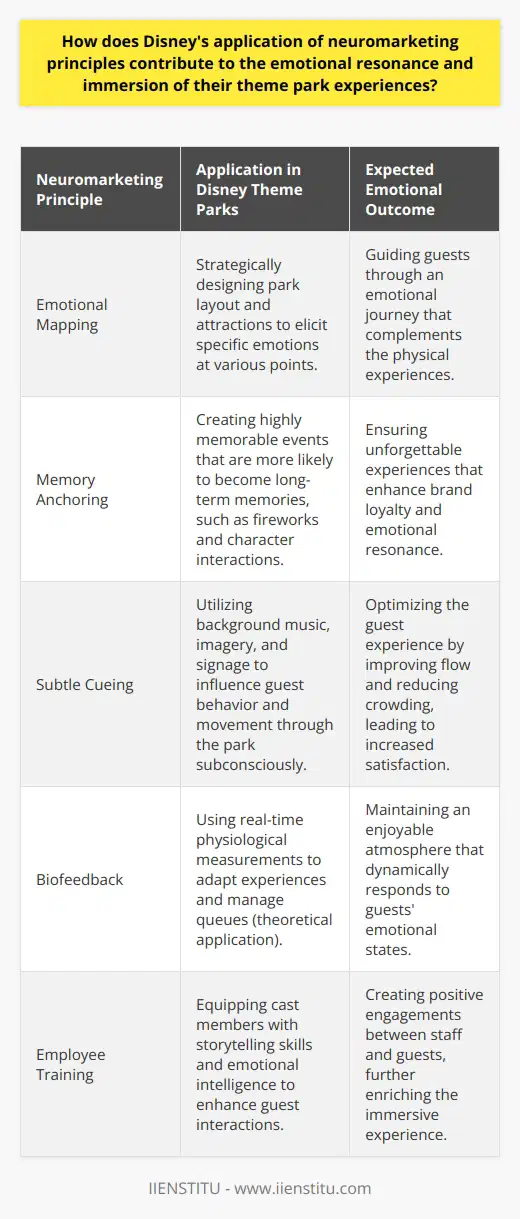
What role does neuromarketing play in Coca Cola's ad campaign development and messaging efficacy?
Role of Neuromarketing in Coca Cola's Ad Campaign Development
Neuromarketing, a marketing strategy that applies neuroscience principles, has a significant role in Coca Cola's ad campaign development. By understanding consumers' cognitive, emotional, and sensorimotor responses to marketing stimuli, Coca Cola optimizes its advertising strategies to accomplish its primary goal: evoking a connection with the audience and influencing their purchasing behavior.
Incorporating Neuroscience Principles
Coca Cola incorporates neuroscience principles in various aspects of its ad campaigns. For instance, it employs functional Magnetic Resonance Imaging (fMRI) to analyze consumers' brain activity when exposed to advertisement materials. By identifying the brain regions associated with positive emotions, Coca Cola can fine-tune its marketing materials to maximize its desired impact on the target audience.
Utilizing Emotional Triggers
One of the primary goals of neuromarketing is to exploit emotional triggers to influence consumers' decision-making processes. Coca Cola effectively achieves this by tapping into the power of nostalgia and creating a sense of familiarity. The brand's long-standing, worldwide presence has been instrumental in forming a deep connection with consumers, establishing a unique emotional bond that transcends generations.
Inclusive and Diversified Messaging
Coca Cola utilizes the insights gained from neuromarketing research to develop ad campaigns that celebrate inclusivity and diversity. By targeting various demographic groups through tailored messaging, Coca Cola strengthens its emotional connection with members of these communities. These tailored strategies demonstrate a deep understanding of the customers' needs, values, and cultural backgrounds.
Evoking Sensory Experiences
Another effective neuromarketing strategy employed by Coca Cola is the stimulation of sensory experiences. The company leverages different marketing channels, including visual, auditory, and even olfactory stimuli, to associate its products with positive experiences. For example, Coca Cola's Christmas campaign features heartwarming visuals, cheerful music, and festive colors, evoking emotions of happiness, warmth, and belonging.
In summary, neuromarketing plays a crucial role in Coca Cola's ad campaign development and messaging efficacy. By incorporating neuroscience principles, leveraging emotional triggers, crafting inclusive and diversified messaging, and evoking sensory experiences, Coca Cola maximizes its advertising impact on consumers, firmly maintaining its position as a global leader in the highly competitive market.
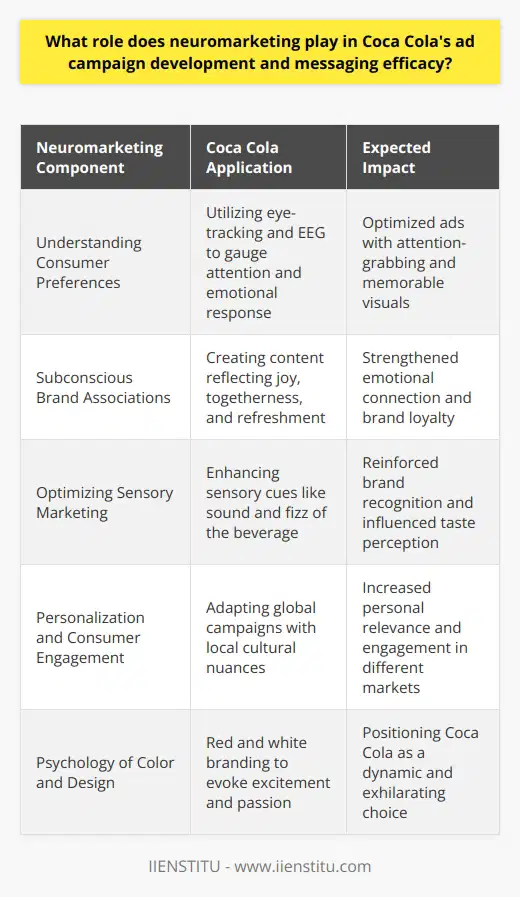
How does Disney use neuromarketing research to influence the design and navigation of their theme parks?
Neuromarketing and Disney Theme Parks Design
Disney utilizes neuromarketing research to design and navigate their theme parks by understanding the visitors' cognitive processes and emotional reactions, aiming to create positive experiences and facilitate strong memories. One key element to implement this approach is tracking the visitors' eye movements, which enables insight into their interests and how they make decisions while navigating the park.
Sensory Stimulation and Emotional Engagement
Neuromarketing studies reveal the importance of sensory stimulation in enhancing emotional engagement, prompting Disney to incorporate sensory experiences into their theme park designs. These experiences involve a strategic use of colors, sounds, smells, and tactile elements to create memorable and positive emotions. For instance, the distinct aroma of popcorn near Main Street or the carefully curated background music that accompanies visitors throughout the park contributes to an immersive experience.
Visitor Behavior Analysis and Decision-making
Disney theme parks leverage neuromarketing research in analyzing visitor behavior and decision-making patterns to influence the design and navigation of the park's spaces. By closely observing how visitors interact with the environment and respond to various stimuli, the company gains valuable insights into decision-making processes. These data drive the design of park layouts, merchandising strategies, and queuing systems. Consequently, visitors are more likely to make choices and become more engaged with the park's offerings.
Subconscious Triggers and Prosocial Behavior
Disney also recognizes the impact of subconscious triggers on prosocial behavior and capitalizes on this knowledge to promote positive interactions between visitors. Neuromarketing research has shown that prosocial behavior can enhance a person's enjoyment of an experience, and this principle is applied within the theme parks. For example, Disney introduced curved pathways to encourage visitors to slow down and interact more with their surroundings and other park guests, contributing to a more pleasant social atmosphere.
Memory Encoding and Connection Building
Lastly, Disney theme parks employ neuromarketing research to promote strong connections between visitors and their experiences to create lasting and positive memories. Memory encoding and recall processes are crucial in establishing long-term brand loyalty, and the theme parks are designed to foster such connections. This is particularly evident in the interleaving of popular characters and storylines into the attractions – an approach that effectively contributes to Disney's success as a global entertainment brand.
In conclusion, Disney's incorporation of neuromarketing research into their theme park design and navigation showcases the company's commitment to understanding and enhancing visitor experiences. By emphasizing positive emotional engagement, sensory stimulation, prosocial behavior, and memory encoding, Disney theme parks set a benchmark for exceptional guest experiences in the entertainment industry.
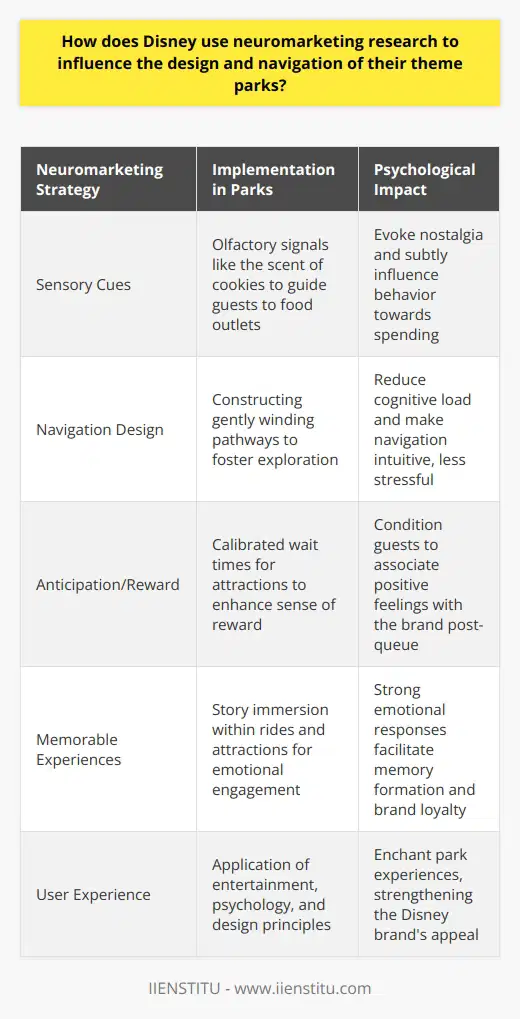
In what ways does Google's use of neuromarketing inform and enhance their algorithm development and user personalization?
**Neuromarketing's Impact on Algorithm Development**
Google employs neuromarketing principles to better understand consumer behavior, which enables them to refine and enhance their algorithms. By analyzing consumer responses at a neurobiological level, Google gains insights into emotional reactions and cognitive processes that drive decision-making. These insights help identify patterns and trends, which are then translated into improvements in their search algorithms, resulting in more effective search engine results pages (SERPs).
**Personalization through Understanding User Behavior**
User personalization is another area where Google's use of neuromarketing contributes to their success. By gauging user preferences through a combination of behavioral data and neuroscientific analysis, Google can tailor its search results and online advertising to better resonate with individual users. This understanding of user behavior and preferences allows for more accurate targeting and greater user satisfaction.
**Adaptive Advertisements and Recommendations**
Neuromarketing enables Google to deliver adaptive advertisements and recommendations, further enhancing user experience. By examining emotional and cognitive responses to advertisement content, Google can optimize ad features such as imagery, phrasing, and design. This approach ensures that advertisements are more relevant, memorable, and engaging for users, leading to increased ad interactions and higher conversion rates.
**Driving Innovation through Neuromarketing Insights**
In summary, Google's use of neuromarketing informs and enhances their algorithm development and user personalization by offering deep insights into user behavior at a neurobiological level. These understandings enable Google to make continuous improvements to their search algorithms, refine online advertising practices, and deliver highly personalized user experiences. Neuromarketing thus serves as a driving force of innovation, enabling Google to maintain its competitive edge and solidify its position as a global leader in the digital landscape.
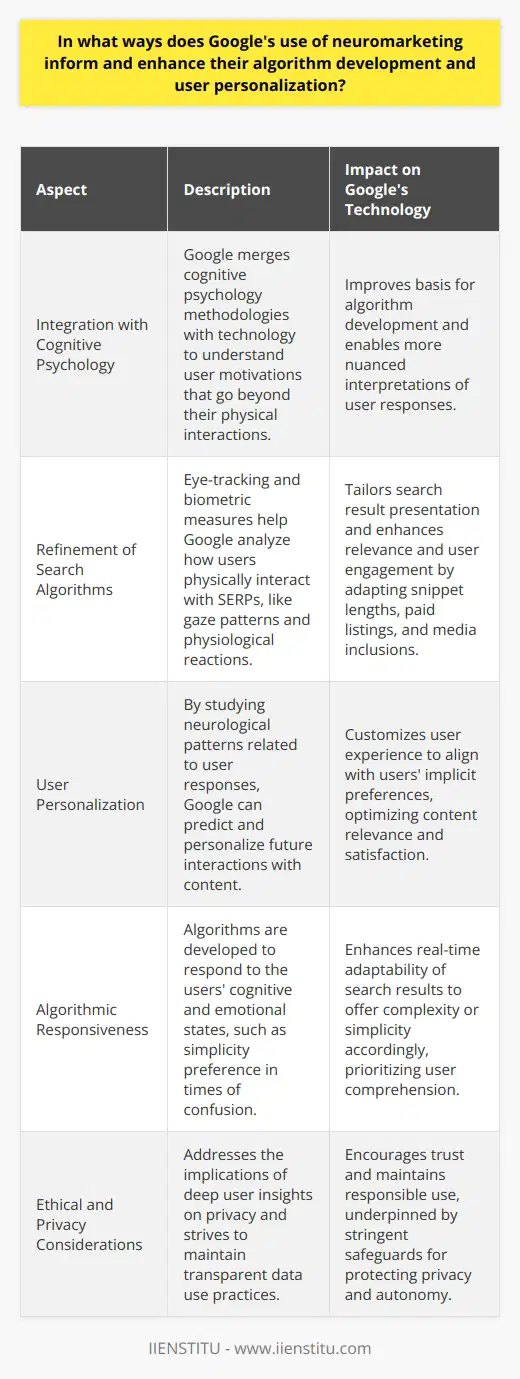
How does Coca-Cola utilize neuromarketing techniques to evoke emotional responses and create memorable experiences for consumers?
Neuromarketing Techniques in Coca-Cola
Understanding Neuromarketing
Neuromarketing is the application of neuroscience principles to analyze and understand consumer behavior. Companies use it to influence buyer decisions, create lasting impressions, and evoke emotions. Coca-Cola is one such company that effectively incorporates neuromarketing strategies into its advertising campaigns.
Emotional Appeals in Advertisements
Coca-Cola primarily focuses on emotional appeals in its commercials. By associating their products with happiness, joy, and connection, they establish an emotional connection with the audience. These positive emotions increase the likelihood of consumers choosing Coca-Cola, creating a strong brand association.
Utilization of Nostalgia
Another neuromarketing technique Coca-Cola employs is nostalgia. By incorporating elements from the past, such as classic jingles, they evoke emotions of happiness and security associated with earlier times in consumers' lives. This strategy can make the brand feel more familiar and trustworthy.
Visual Elements
Coca-Cola uses distinct visual elements to create memorable experiences. This strategy includes the consistent use of specific colors, shapes, and images to stimulate the brain's neural response. The red and white color scheme, for example, has become synonymous with the brand and can evoke feelings of excitement and passion.
Sensory Branding
The company also employs sensory branding as part of their neuromarketing tactics. Coca-Cola utilizes sound, smell, and taste to create a multi-sensory experience for the consumer. The sound of a can being opened or the fizzing noise when pouring a Coke can trigger emotions of comfort and pleasure, enhancing brand recall and loyalty.
Social Connections and Experiences
Coca-Cola further capitalizes on the human need for social connections and shared experiences. They promote group gatherings, bonding, and celebrations by incorporating the product into these events. This tactic strengthens the emotional bond between consumers and the brand, making it an integral part of cherished memories.
In conclusion, Coca-Cola effectively utilizes a range of neuromarketing techniques to evoke emotional responses and create memorable experiences for consumers. By appealing to emotions, incorporating nostalgia, using distinct visual elements, employing sensory branding, and promoting social connections, Coca-Cola has been able to maintain a strong brand presence globally.
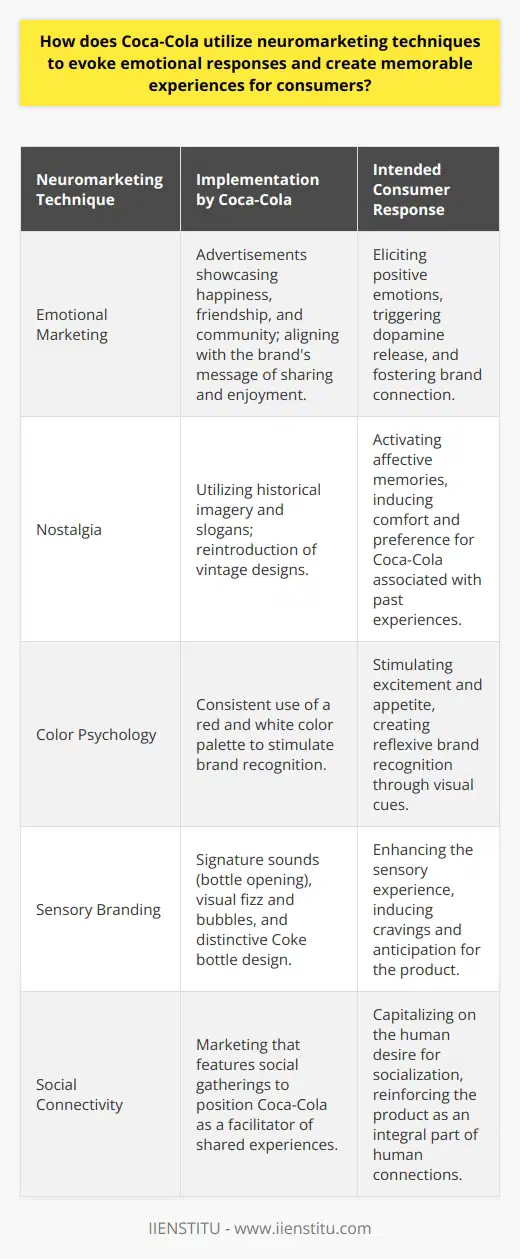
How does Disney incorporate neuromarketing principles into their character development and storytelling techniques to elicit specific emotional responses?
Incorporating Neuromarketing Principles
Disney utilizes neuromarketing principles in their character development and storytelling tactics to evoke desired emotional responses from their audience. This process involves understanding the psychological triggers that influence consumer behavior and catering to those triggers through strategic planning and design. Disney uses these principles to ensure a positive emotional experience for their viewers.
Appealing to Emotions and Memory
One major component of neuromarketing is generating an emotional response. Disney achieves this by creating lovable characters, often by combining familiar and desirable traits. Through careful research, Disney identifies the features that elicit positive emotions and embeds them into their characters, building strong emotional connections with the audience. They also pay close attention to the emotions evoked during pivotal moments in the story, using suspense, humor, and drama to increase emotional intensity, and effectively etching these moments into the viewers' memory.
The Power of Visual/ Auditory Stimuli
Disney recognizes the importance of strong visual and auditory stimuli to trigger emotional responses. By using bright colors, detailed animations, and captivating soundtracks, they immerse their audience in a vivid sensory experience. These elements are specifically chosen to elicit emotions such as joy, excitement, and wonder. Disney also understands that humans are naturally drawn to faces, allowing them to successfully use anthropomorphism to make non-human characters just as relatable and emotive as their human counterparts.
Building and Utilizing Nostalgia
Nostalgia plays a crucial role in Disney's neuromarketing strategy. By tapping into fond childhood memories, Disney can create strong emotional bonds with their viewers. This can be achieved through the revival of favorite characters and stories or the use of sentimental music and visuals. In doing so, the audience's brain releases feel-good chemicals like dopamine and oxytocin, forging a deep emotional connection between the viewer and the brand.
The Importance of Story Structure
Finally, Disney adheres to the classic three-act story structure, imbuing their stories with a familiar and satisfying rhythm. This structure allows for the portrayal of relatable themes like overcoming obstacles, personal growth, and the power of love, enabling viewers to become emotionally invested in the narrative. As a result, this emotional investment lingers in their mind and develops into loyalty towards the Disney brand.
In conclusion, Disney excels in the art of using neuromarketing principles to craft compelling characters and unforgettable stories. By combining emotional triggers, strategic visual and auditory stimuli, nostalgia, and classic story structures, they ensure a memorable and emotionally charged experience for their audience, cementing their reputation as a beloved and enduring entertainment giant.
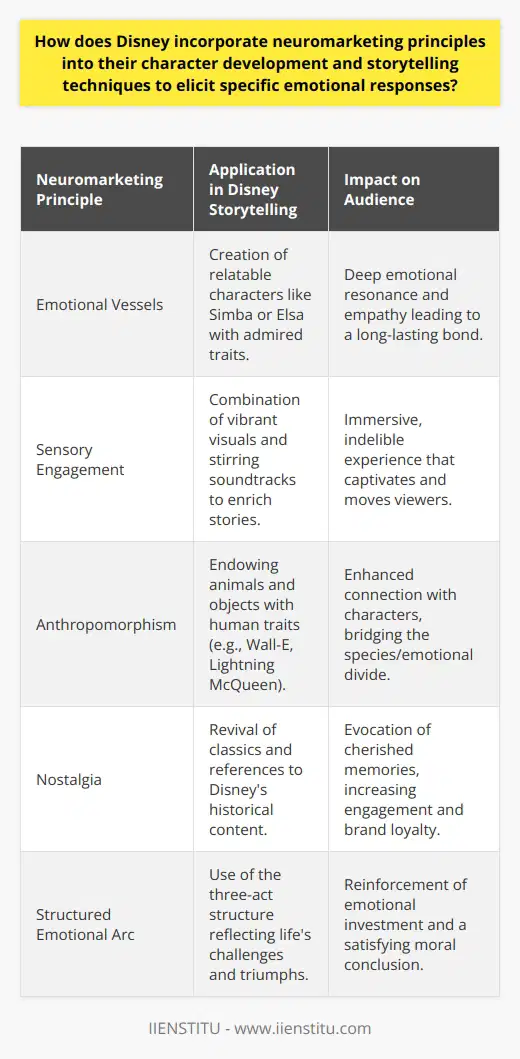
How does Google's use of neuromarketing influence the design and layout of their platforms to ensure an optimal user experience?
Neuromarketing in Google's Platform Design
Neuromarketing is the science of applying cognitive neuroscience principles to advertising and marketing strategies. Google harnesses these principles to create a more efficient and enjoyable user experience, attracting and retaining users while maximizing conversion rates.
Emphasis on Visual Stimuli
One key aspect of neuromarketing in Google's platform design is the focus on visual stimuli. Human brains process visuals 60,000 times faster than texts. Therefore, Google's design approach prioritizes images and videos, making their platforms visually appealing and easy to understand at a glance. This eventually creates lasting impressions that generate positive user emotions, leading to higher user engagement and potential ad revenue.
Effective Color Psychology
Color plays a vital role in influencing users' emotions and decision-making. Google's platforms extensively utilize color psychology to evoke particular feelings or reactions. The company chooses vibrant and friendly colors, such as their iconic blue for hyperlinks or red for CTAs (Call To Action). These colors not only catch attention but also promote clarity, trustworthiness, and a welcoming atmosphere, ultimately inspiring users to interact with the platform more.
Cognitive Load Reduction
Reducing users' cognitive load is essential in creating an optimal user experience. Google achieves this by minimizing distractions, simplifying navigation, and offering personalized recommendations. The platforms present information in an organized and clean layout, with ample white space that ensures users can focus on the content without feeling overwhelmed. Users can quickly find what they want, reducing mental effort and increasing overall satisfaction.
Fostering Emotional Connections
Emotional engagement is a crucial element of neuromarketing. Google cultivates emotional connections with users by incorporating storytelling elements, relatable imagery, and user-generated content. Furthermore, features such as Google Doodles and personalized search results create a sense of familiarity and rapport between the brand and its users. These emotional connections foster brand loyalty and increase the likelihood of users advocating for the platform.
Adaptive Design and Layout
Lastly, Google employs adaptive design and layout to accommodate various user preferences, device types, and accessibility needs. Embracing a 'mobile-first' approach, the platforms ensure that users have a seamless experience regardless of screen size, device, or location. Additionally, incorporating accessibility features enhances the experience for users with disabilities, catering to a wider audience and showcasing the company's commitment to inclusivity.
In conclusion, Google's use of neuromarketing significantly influences the design and layout of their platforms. The company employs a combination of visual stimuli, color psychology, cognitive load reduction, emotional connections, and adaptive design to create an optimal user experience. By understanding and leveraging human cognition, Google successfully attracts and retains users while generating higher conversion rates and user satisfaction.
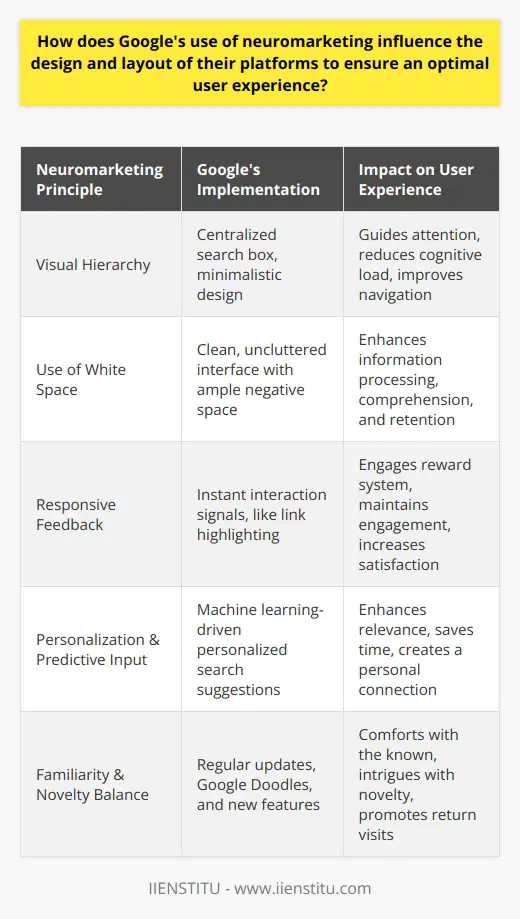
What is the role of neuromarketing in informing brand strategies and enhancing customer engagement?
Role of Neuromarketing in Brand Strategies
Neuromarketing plays a significant role in informing brand strategies and enhancing customer engagement by employing the latest knowledge in neuroscience. Brands can leverage neuromarketing insights to develop marketing campaigns that are intricately designed to elicit desired emotional responses and behaviors from consumers. Ultimately, this helps in building strong brand-customer relationships.
Emotional Triggers and Decision-Making
Neuromarketing helps in uncovering the emotional triggers that impact consumer decision-making processes. By understanding the cognitive and emotional responses to various stimuli, brands can tailor their marketing messages to evoke specific emotions. These emotions can influence the consumer's perception of the brand and ultimately, their purchasing decisions.
Personalization and Customization
By tapping into the subconscious thoughts and preferences of consumers, neuromarketing allows brands to personalize and customize their offerings. Personalization can manifest in different forms, such as the presentation of tailored advertisements or the development of unique product experiences. This targeted marketing approach leads to a more intimate connection with potential consumers, fostering long-lasting brand loyalty.
Neuroimaging and Advertising Optimal Design
Neuromarketing employs neuroimaging technologies, such as functional magnetic resonance imaging (fMRI), and electroencephalography (EEG), to determine the effectiveness of marketing materials. By analyzing brain activity while consumers are exposed to advertisements, brands can optimize the design of their campaigns for maximum impact. This data-driven approach helps brands make informed decisions that resonate with their target audience.
Consumer Satisfaction and Loyalty
Understanding the neurological factors that contribute to consumer satisfaction supports brands in developing strategies to ensure customer loyalty. By fostering positive experiences and associations with their products and services, brands can create lasting connections with consumers. Repeat purchase behaviors, accompanied by positive word-of-mouth marketing, are beneficial consequences of harnessing the power of neuromarketing.
In conclusion, neuromarketing informs brand strategies and enhances customer engagement by shedding light on the cognitive and emotional mechanisms underlying consumer decision-making. Through its insights on personalization, design optimization, and consumer satisfaction, neuromarketing helps brands deliver targeted and impactful marketing campaigns that foster long-term relationships with their consumers.
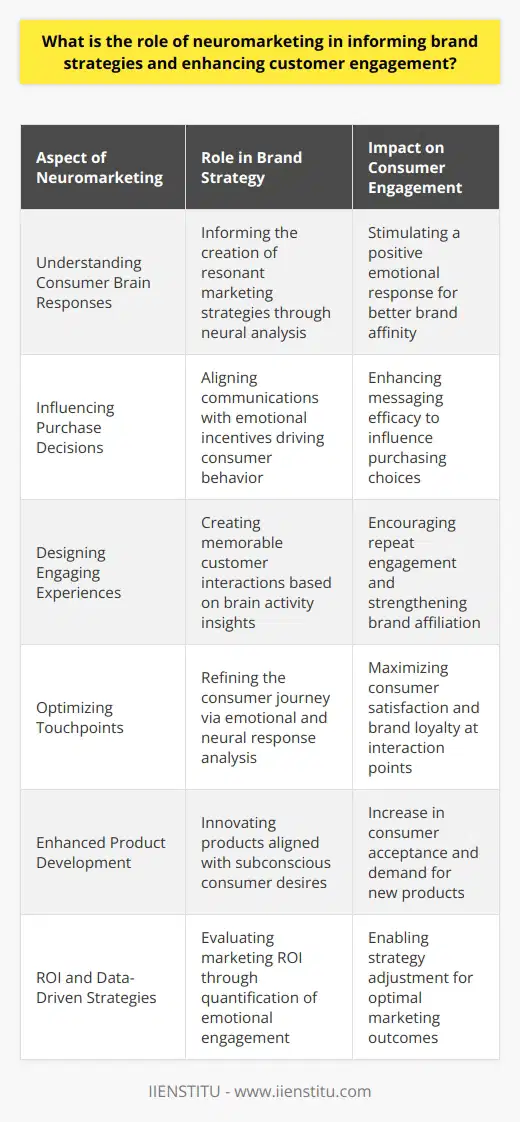
How do companies leverage neuroscience research to better understand consumer decision-making processes and preferences?
Neuroscience Insights in Marketing
Companies increasingly rely on neuroscience research as a tool to gain insight into consumer decision-making processes and preferences. By utilizing techniques such as functional magnetic resonance imaging (fMRI) and electroencephalography (EEG), marketers can directly observe brain activity and measure responses to various stimuli, such as advertisements, packaging, and pricing.
Emotion-driven Decisions
One key finding is that emotions play a crucial role in consumer behavior. Neuroscience studies reveal that consumers often make decisions based on emotional reactions rather than logical reasoning. By understanding these emotional triggers, companies can tailor their marketing strategies to elicit specific emotional responses, leading to increased customer engagement and ultimately, greater sales.
Cognitive Biases
Another important contribution of neuroscience to marketing is the identification of cognitive biases, which can help companies better understand consumer preferences. For example, the anchoring effect demonstrates that the perception of value can be significantly influenced by the first piece of information presented. Recognizing such biases allows marketers to strategically introduce pricing and offers in ways that maximize the perceived value of their products.
Attention and Memory
Neuroscience research also provides insights on how to capture and retain consumer attention. Studies show that attention is a limited resource, and marketers need to create compelling content that stands out amidst the constant barrage of information and stimuli. Furthermore, by understanding the neural mechanisms of memory formation, companies can create marketing materials that are more likely to be encoded into long-term memory, enhancing brand recall and loyalty.
Personalized Experiences
Finally, leveraging neuroscience allows companies to develop personalized customer experiences. By understanding consumer preferences and the psychological processes underlying decision-making, companies can create tailored marketing campaigns and product offerings that resonate more deeply with individuals. This targeted approach results in more efficient and effective use of marketing resources and elevates customer satisfaction.
In conclusion, companies that harness the power of neuroscience research can better understand the intricacies of consumer decision-making processes and preferences, enabling them to create marketing strategies that are more emotionally engaging, cognitively persuasive, and personalized. As a result, these businesses are better equipped to navigate the competitive landscape and stand out in the minds of consumers.
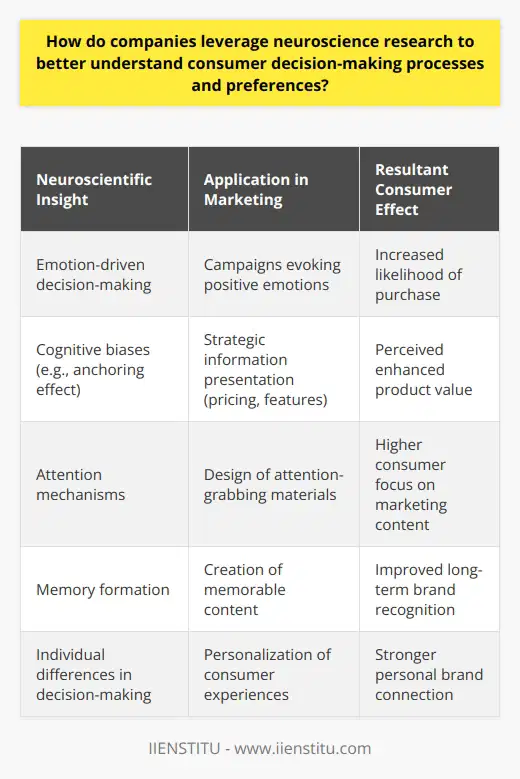
What are some successful neuromarketing techniques utilized by industry-leading companies to optimize product and service offerings?
Neuromarketing Techniques
Neuroscience and Psychology in Advertising
Several industry-leading companies utilize various neuromarketing techniques to optimize their products and services. One successful approach is incorporating principles of neuroscience and psychology into advertising campaigns. Companies such as Coca-Cola and Google have adopted this strategy to evoke emotional responses that positively influence consumer behavior.
Eye-Tracking and Visual Attention
Eye-tracking technology plays a significant role in identifying the crucial elements that capture consumers' visual attention. Retailers like Amazon and Walmart use this technique to optimize the layout of their websites, ensuring that essential product features and promotional graphics are prominently displayed to encourage customer engagement.
Emotional Connection and Storytelling
The power of storytelling is another effective neuromarketing technique employed by industry leaders like Apple and Nike. They skillfully create compelling narratives that evoke an emotional connection with potential customers, leading to increased brand loyalty and product desirability.
Consumer Decision-Making Process
Understanding the consumer decision-making process is fundamental to optimizing products and service offerings. Brands like Netflix and Spotify leverage data-driven neuromarketing strategies to curate personalized content recommendations, enhancing user experience and satisfaction.
Sensory Marketing and Packaging
Sensory marketing, which evokes specific emotional responses from customers through visual, auditory, and tactile stimuli, is another successful neuromarketing methodology. Top-tier companies, such as Nestlé and Unilever, invest in visually appealing and ergonomic packaging to captivate their target audience, boosting their products' in-store and online appeal.
In conclusion, neuromarketing techniques are well-established and effective tools that industry-leading companies employ to optimize products and service offerings. Incorporating neuroscience and psychology principles, using eye-tracking technology, creating emotional connections through storytelling, understanding the decision-making process, and implementing sensory marketing strategies can all contribute to increased brand loyalty and consumer engagement.

How do neuromarketing techniques inform the development and execution of successful advertising campaigns by major brands?
Neuromarketing: A Key Tool for Major Brands
Understanding Consumer Behavior
Neuromarketing techniques have become an essential tool for major brands in the development and execution of successful advertising campaigns. These methods focus on the study of the consumer's subconscious response to various stimuli, determining their preferences, emotions, and decision-making processes linked to the consumption of products and services. By examining how the brain responds to specific advertising images, sounds, or messages, marketers can create more effective and targeted campaigns.
Applying Neuroscience Findings
In recent years, there has been a significant increase in the application of neuroscientific findings to the advertising industry, as brands seek to understand their consumers on a deeper level. Techniques such as functional magnetic resonance imaging (fMRI), electroencephalography (EEG), and eye-tracking are employed to observe brain activity and gather valuable insights on consumer preferences and engagement. This data is then used to optimize advertising campaigns, focusing on factors that elicit the strongest emotional responses and trigger positive associations with the product or brand.
Emotional Connection and Memory
One of the key aspects of neuromarketing is the importance of connecting emotionally with consumers. Research has shown that advertisements that evoke strong emotions are more likely to leave a lasting impression and influence decision-making. By utilizing neuromarketing techniques to identify patterns of emotional arousal, marketers can craft advertisements that resonate with their target audience, creating a lasting and impactful connection with the brand.
Persuasion Through Subliminal Messages
Another effective strategy employed through neuromarketing is the use of subliminal messaging. These subtle, often subconsciously-perceived cues can influence consumer behavior without their awareness. Marketers may incorporate subliminal messages in headlines, images, or background elements of an advertisement to subtly guide consumer preferences and purchase decisions. By tapping into the subconscious mind and employing persuasive techniques, advertisers can create a powerful impression of their brand that can ultimately drive sales.
In conclusion, neuromarketing techniques have become increasingly crucial to the development and execution of successful advertising campaigns by major brands. By leveraging insights obtained from neuroscientific research, advertisers can better understand consumer behavior, craft emotionally-resonant messages, and employ subtle persuasion techniques to influence purchasing decisions. As the field continues to advance, it is expected that neuromarketing will play an even more prominent role in shaping the future of advertising strategies.
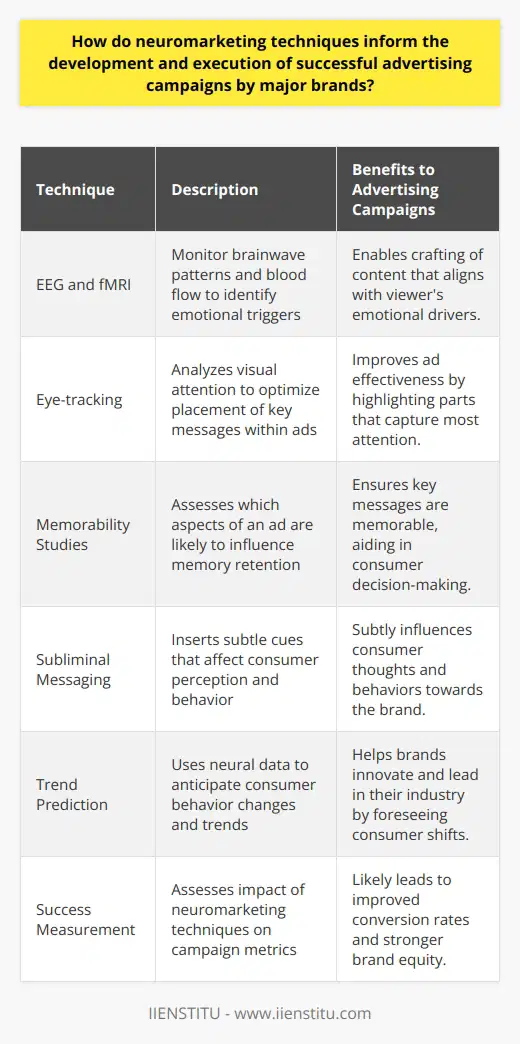
In what ways do companies like Disney and Google utilize neuromarketing to maximize user satisfaction and engagement?
Understanding Neuromarketing
To comprehend how companies like Disney and Google employ neuromarketing, it is crucial to understand what it is. Neuromarketing is the application of neuroscientific research on consumer behavior to optimize marketing techniques and enhance user satisfaction and engagement. Both Disney and Google use neuromarketing tactics to create positive emotional connections with their users, encourage brand loyalty, and improve user experiences.
Emotional Connections and Brand Loyalty
One of the main objectives of neuromarketing is to create positive emotional connections with consumers, and both Disney and Google have mastered this strategy. Disney, for instance, generates nostalgia through their movies, merchandise, and theme parks. This nostalgia creates strong emotional connections that evoke happiness, allowing consumers to associate positive emotions with Disney's brand. Similarly, Google leverages their recognizable and straightforward logo to spark familiarity and trust in their users. By pursuing emotional branding, both companies establish long-term relationships and brand loyalty with their audience.
Enhancing User Experience
A significant component of neuromarketing is enhancing user experience by making products and services more appealing and user-friendly. Disney provides immersive and interactive experiences through their theme parks, creating unforgettable, sensory-rich memories that further solidify positive associations with their brand. Alternatively, Google focuses on creating an efficient and intuitive user interface for their search engine and other services. Through neuromarketing, they continuously improve design elements, making them more accessible and easier to use, which ultimately attracts and retains users.
Personalization and Targeted Marketing
Another neuromarketing tactic both Disney and Google employ is personalization and targeted marketing. Disney, for instance, uses data gathered from users to provide personalized recommendations on their streaming platform, Disney+. This personalization tailors content to individual preferences, increasing user satisfaction and engagement. Google, on the other hand, employs targeted marketing by analyzing their users' search behavior and serving relevant ads. This practice allows advertisers to reach audiences who are most likely to be interested in their products, creating a more engaging user experience.
In conclusion, companies like Disney and Google use neuromarketing to maximize user satisfaction and engagement by creating emotional connections, enhancing user experiences, and employing personalization and targeted marketing. By continually adapting to consumer behavior, these companies have the potential to remain successful and keep consumers coming back for more.
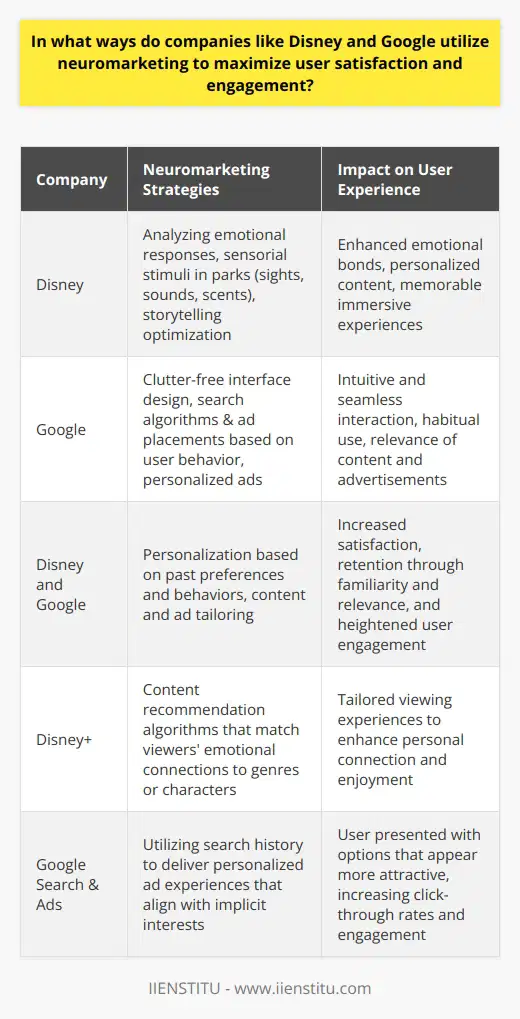
What are some real-life examples of how neuromarketing insights have led to innovations in product design and customer experiences across various industries?
Neuromarketing Applications in Product Design
Over the years, an increasing number of industries have benefitted from neuromarketing insights, ultimately transforming product designs and enhancing customer experiences. These advancements stem from observing consumers' neurological responses to stimuli, garnering a deeper understanding of consumer behavior and preferences. This scientific approach has led to innovative product designs and improved customer experiences across various industry sectors.
Packaging Design and Consumer Engagement
One of the compelling examples of neuromarketing application lies in the redesign of packaging to evoke a more positive consumer response. For instance, neuromarketing studies have demonstrated that certain colors, shapes, and patterns can facilitate emotional attachment, compelling consumers to choose a particular product over another. Companies such as Nestlé and Unilever have applied these principles to their packaging designs to attract and retain customers effectively.
Retail Space Optimization
Neuromarketing techniques have also played a significant role in optimizing retail spaces to encourage consumer spending. By using eye-tracking technologies, retailers assess consumers' attention patterns and use this information to design store layouts, window displays, and product arrangements to boost shopper engagement. Companies such as Walmart have successfully employed these strategies to improve sales conversions and augment customer shopping experiences.
Digital Advertisement Personalization
Various insights from neuromarketing studies have fueled the creative process behind digital advertisements. These personalized experiences not only increase consumer attention but also foster lasting connections with the target audience. By examining neural activations, marketers have developed engaging ad campaigns that evoke emotional responses and effectively resonate with consumers' preferences, such as Coca-Cola's successful Share a Coke campaign.
Emotional Branding and Connection
Neuromarketing insights have significantly impacted how brands establish a long-lasting emotional connection with their customers. A prime example of this approach is Apple's product launches – curated events that create an aura of exclusivity and anticipation around the brand's products. These tactics contribute to the emotional association consumers have with the brand, increasing loyalty and overall customer satisfaction.
In conclusion, the implementation of neuromarketing insights across various industries has led to remarkable innovations in product design and customer experiences. By examining consumers' neurological responses to various stimuli, companies can better understand their target audience, and thus, create tailored strategies to engage and retain customers effectively.
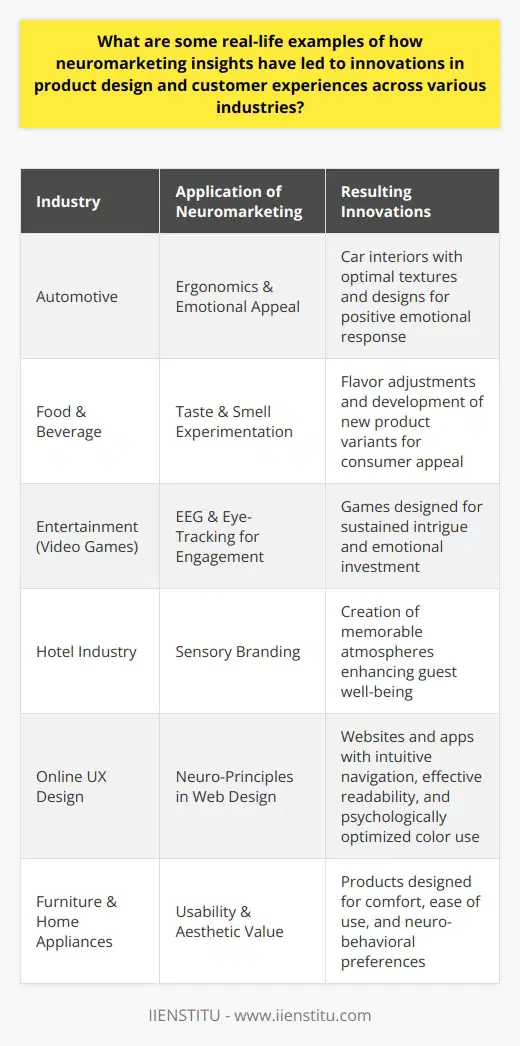
What companies are using neuromarketing to optimize their advertising and user experience strategies?
Neuromarketing Applications in Advertising
A growing number of companies are employing neuromarketing techniques to optimize their advertising and user experience strategies. This approach allows them to better understand consumer behavior and preferences, leading to more effective campaigns and increased engagement.
Integration by Tech Giants
Prominent companies like Google and Facebook utilize neuromarketing insights to tailor their advertising platforms. This enables them to deliver highly relevant ads based on individual users' preferences and browsing history, thus increasing ad effectiveness and user satisfaction.
Adoption by Retail Brands
Major retail brands, such as Amazon and Walmart, implement neuromarketing to optimize their online shopping experience. By analyzing consumers' neurological responses, they can improve website design, personalize product recommendations, and create content that resonates with their target audience.
Influence on Luxury Brands
Luxury brands like Mercedes Benz and Rolex also harness neuromarketing data to craft impactful advertising campaigns. By tapping into consumers' emotional and cognitive responses, they can create compelling narratives that evoke a strong emotional connection to their products, thereby enhancing brand loyalty.
Integration in Fast Food Industry
Fast-food chains like McDonald's and Burger King use neuromarketing as a part of their product development and promotional strategies. This enables them to develop menu items that appeal to customers on a neurological level, as well as create advertisements that elicit hunger and cravings.
Impact on Entertainment Industry
Major players in the entertainment industry, such as Netflix and Spotify, incorporate neuromarketing findings to customize user recommendations and create content that is more likely to capture users' attention and evoke positive emotions.
Role in Gaming Development
Video game developers like Electronic Arts (EA) and Activision Blizzard use neuromarketing techniques to refine game mechanics and design, ensuring their products are not only engaging and immersive but also offer reward pathways that keep players addicted and coming back for more.
In conclusion, a diverse range of companies across various industries are increasingly embracing neuromarketing as a tool to optimize advertising and user experience strategies. By better understanding the human brain, these companies can create more effective campaigns, tailored content and ultimately, foster stronger connections between consumers and their products.
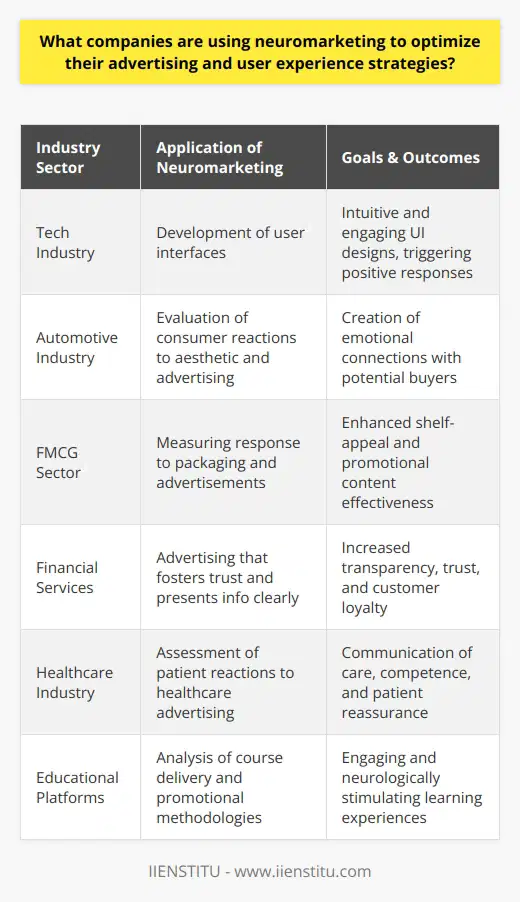
How does Cheetos utilize neuromarketing techniques to appeal to consumers and drive product sales?
Neuromarketing and Cheetos
Understanding Brain Processes
Cheetos employs neuromarketing techniques to analyze consumers' unconscious reactions to its product. Neuromarketing is the study of brain activity responses to marketing stimuli using technologies such as electroencephalography (EEG), aimed at insightful decision-making. By revealing hidden preferences and emotions, Cheetos can tailor their marketing initiatives effectively.
Appealing to Sensory Desires
Cheetos prioritizes appealing to customers' sensory desires through stimulating visuals and sounds. The vibrant orange color of the snack excites consumers, while the crunchy sound and texture create a satisfying experience. These sensory elements trigger pleasure centers in the brain and influence purchasing decisions.
Executing Reward-Driven Strategies
Cheetos capitalizes on the concept of reward-driven behavior by implementing promotions, limited edition products, and contests. These tactics stimulate the release of dopamine, a brain chemical responsible for reinforcing rewarding behaviors. As a result, consumers become driven to purchase Cheetos to satisfy their craving for both the product and the reward.
Leveraging Emotional Associations
Emotion plays a crucial role in Cheetos marketing, as demonstrated by their iconic mascot, Chester Cheetah. He evokes feelings of playfulness, fun, and mischief, which creates a strong emotional connection to the brand. This strategy taps into the brain's limbic system, the emotional decision-making center, to build brand loyalty and drive sales.
Creating Novel Experiences
Cheetos also focuses on developing unique product experiences to evoke curiosity in consumers. For example, the introduction of Flamin' Hot Cheetos created a buzz among snack enthusiasts and generated excitement with its bold and spicy flavor profile. The novelty of such products stimulates the brain's pleasure centers, prompting consumers to seek out and purchase these new experiences.
In conclusion, Cheetos successfully employs neuromarketing techniques, such as sensory appeals, reward-driven strategies, emotional associations, and novelty, to understand and influence consumer behavior. These tactics directly target the brain's decision-making processes, ultimately driving product sales and cultivating a loyal customer base.
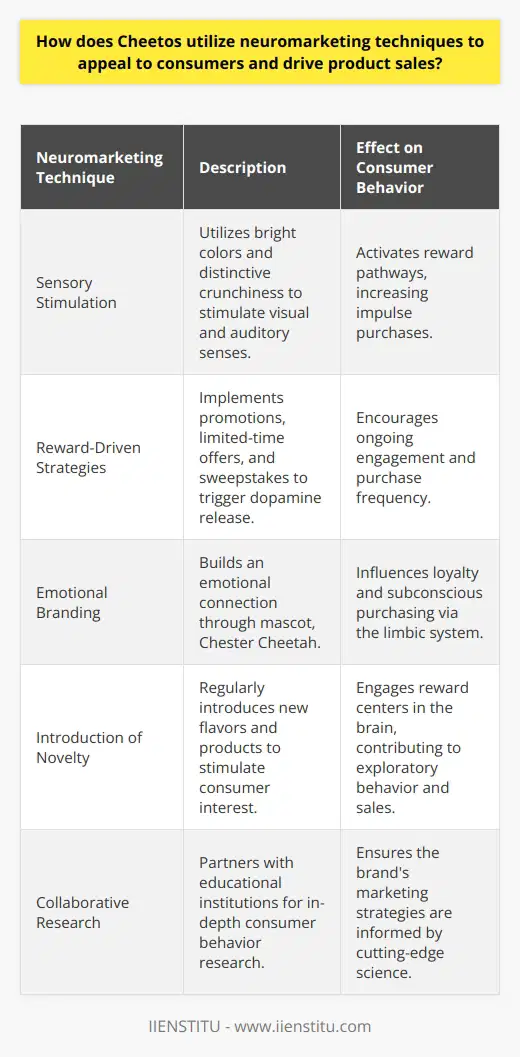
What is a real-life example of neuromarketing successfully influencing consumer behavior and decision-making processes?
Real-Life Example of Neuromarketing
A notable example of neuromarketing successfully influencing consumer behavior and decision-making processes is the 2010 PepsiCo experiment. This beverage company, known for its iconic soft drinks such as Pepsi and Mountain Dew, has used neuromarketing techniques to gain insights into consumer behavior and improve marketing efforts.
Understanding Consumer Preferences
To understand consumer preferences, PepsiCo conducted a study using functional Magnetic Resonance Imaging (fMRI). Participants tasted Pepsi and Coca-Cola without knowing the brand of each drink. Their brain activity was monitored while tasting the drinks, and the results showed that participants preferred the taste of Pepsi while they were unaware of the brands they tasted.
Creating an Emotional Connection
The fMRI study provided insights into people's emotional connections and brand preferences, revealing that when participants knew they were drinking Coca-Cola, they were influenced by the brand's strong emotional connection. This led them to report a preference for Coca-Cola, even though they had preferred Pepsi in the blind taste test.
Leveraging Neuromarketing Techniques
Armed with these neuromarketing insights, PepsiCo crafted marketing campaigns aimed at creating stronger emotional bonds with consumers. In 2016, Pepsi launched the PepsiMoji campaign, which featured personalized emojis on their packaging. This connected with consumers emotionally, driving positive brand sentiment and enhancing Pepsi's brand image.
Influencing Consumer Decisions
These neuromarketing strategies have helped PepsiCo strengthen its market position and influence consumer behavior. For instance, during the hugely popular 2018 Pepsi Generations campaign, the company used nostalgic pop-culture references and iconic celebrities to recreate its best advertisements. This tactic resonated with consumers and enhanced their emotional connection with the brand.
Hence, the PepsiCo case demonstrates how neuromarketing, powered by brain imaging and data-driven insights, can enable companies to better understand consumer preferences and design effective marketing strategies. With such information, businesses can create a lasting emotional connection with their target audience, influencing consumer decisions and generating long-term success.
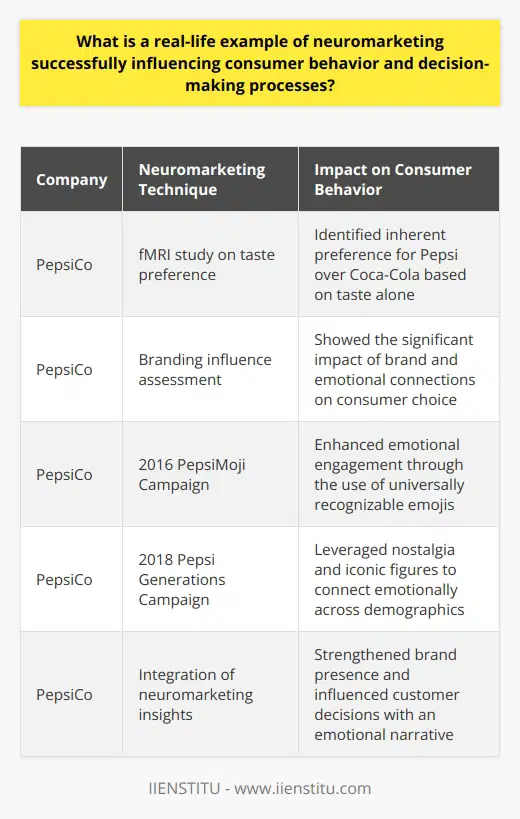
How does Disney use neuromarketing in their animation and film development to evoke specific emotional reactions from viewers?
Neuromarketing Techniques in Disney Animation
Disney's neuromarketing strategies heavily rely on psychological cues to elicit predetermined emotional responses from viewers. Their animators inject subliminal messages into films to influence viewers' perceptions and emotions.
Stimulating Emotional Resonance
Disney explores emotional resonance by focusing on resonating themes such as love, friendship and heroism. They construct narratives that touch deep emotional chords, stimulating emotion-related brain regions. This approach makes viewers feel deeply connected to the story.
Use of Color Psychology
Disney’s animations actively use color psychology. Colors like warm reds or oranges evoke feelings of happiness or excitement, while blues and grays trigger sadness or tranquility. This strategic color selection subconsciously impacts the viewers' emotions.
Manipulation of Character Design
Disney's character design also manipulates viewer's responses. Particularly, they exaggerate facial features to create an immediate emotional connection. For example, characters with big eyes often evoke feelings of empathy due to their childlike innocence.
Eliciting Subconscious Responses
Subconscious responses are elicited through background music and sound effects. Upbeat music generates feelings of joy, whereas loud, abrupt sounds induce shock or fear. Such subconscious responses prime viewers to react in desired ways.
In conclusion, Disney uses neuromarketing techniques extensively in their animation and film development. They manipulate emotional triggers, use color psychology, design empathetic characters, and use soundtracks to induce specific emotions. This ultimately enhances viewer engagement, subsequently contributing to their films' success.
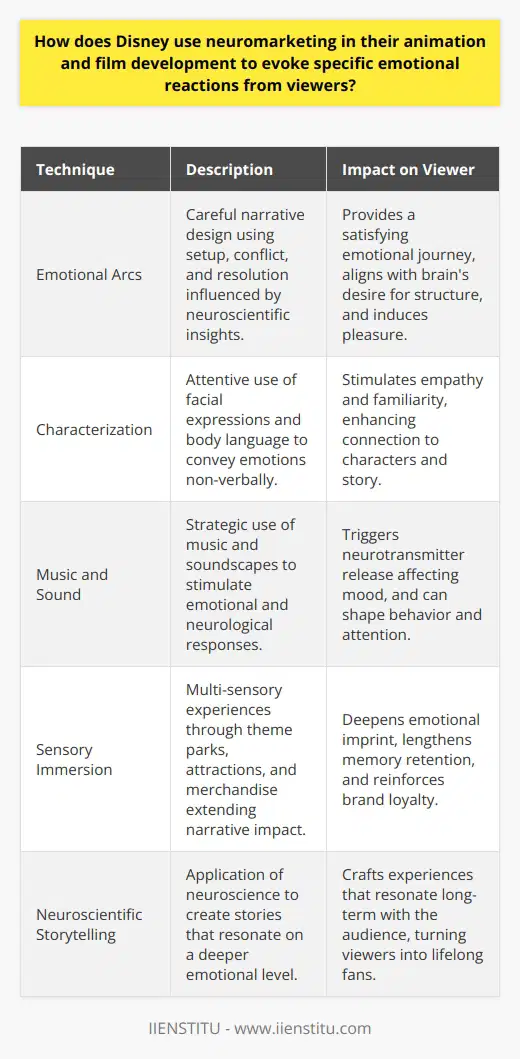
What is a real life example of neuromarketing applied in the fashion industry to improve customer satisfaction and increase sales?
Neuromarketing Application in Fashion
The fashion industry strategically uses a emerging field known as neuromarketing. This bridges the gap between science and consumer behavior to enhance customer satisfaction and increase sales.
H&M's 'Neuro Couture' Project
A key example of using neuromarketing in the fashion industry is H&M's 'Neuro Couture' project. H&M created clothing designs based on consumer brain responses. Customers wearing brainwave-measuring EEG headsets viewed sets of images. Brainwave responses then influenced clothing patterns and designs.
Impacting Consumption Behavior
This innovative approach affected consumers' choice behavior. Consumers felt more emotionally tied to products due to their direct influence on design. It increased product ownership feeling and improved overall customer satisfaction.
Driving Sales Through Behavioral Insights
Neuromarketing techniques also allowed H&M to understand consumers' unconscious reactions to product design. Insights from these responses helped the brand to create products that appeal to the customers' subconscious needs. The application increased sales as people were more likely to buy things that connect at a delicate emotional level.
Looking Towards Future Strategies
Neuromarketing benefits in the fashion industry are clear. Tangible insights from consumer brainwaves allow brands to develop emotionally-resonating products. An increasing number of brands are expected to incorporate such neuromarketing strategies in their customer behavior study and product development process.
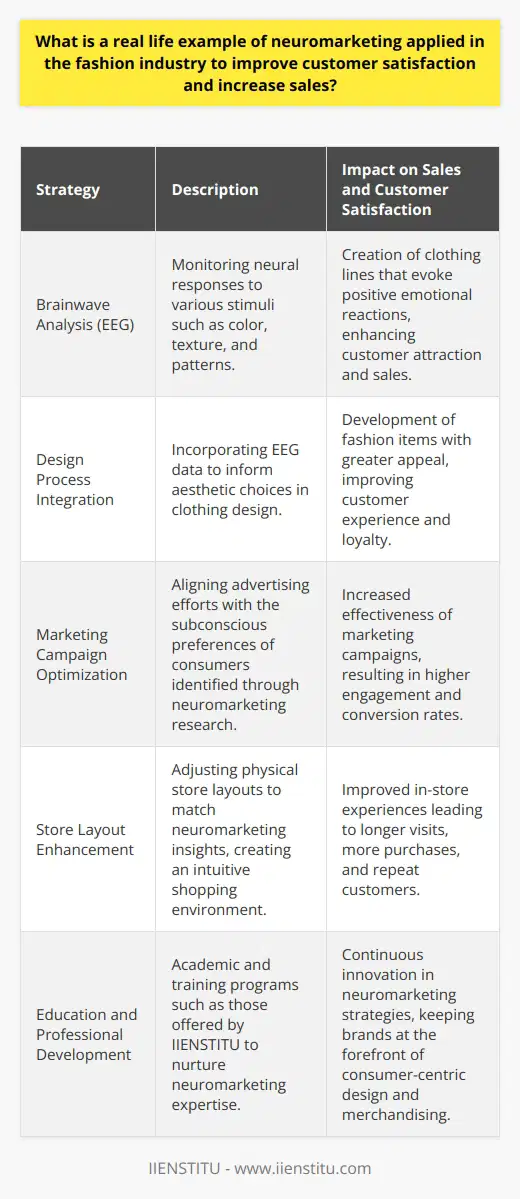
How does PayPal use neuromarketing research to enhance user trust and confidence in their online transaction platform?
Implementation of Neuromarketing Research
Neuromarketing becomes instrumental for PayPal in enhancing user trust and confidence in their online transaction platform. They utilize this marketing technique by studying the neurological responses of users during transactions. Understanding these responses enables them to design a user interface that psychologically appeals to users, thereby boosting engagement and trust in the platform.
Influence of Interface Design
The neuromarketing research guides PayPal's interface design. They focus on simplicity and relevant information presentation in the design. Such design elements tend to decrease anxieties, a crucial aspect of enhancing user trust in online transactions. The user-friendly platform thus provides transparency and predictability.
Incorporation of User Feedback
Furthermore, PayPal uses neuromarketing insights to act upon user feedback. By tracking how users interact with the platform, they identify areas of potential improvements. They then incorporate these changes to fine-tune the user experience, thus amplifying trust and confidence in their services.
Neuromarketing-Powered UX Improvements
The benefits of neuromarketing research are evident in the strategic improvements PayPal makes to its user experience (UX). Visualization enhancements, prompt error messages, and streamlined transaction processes are just a few results of thorough neuromarketing analysis. By making their platform easy to understand, PayPal significantly enhances user confidence in performing online transactions.
Preventing Cognitive Overload
Another essential insight from neuromarketing research that PayPal uses is the prevention of cognitive overload. They accomplish this by ensuring that the amount of information presented does not overwhelm the user. This strategy minimizes stress for users, which in turn fosters confidence and trust.
In conclusion, PayPal implements neuromarketing research to boost user trust and confidence in their platform. By focusing on interface design, leveraging user feedback, improving UX, and preventing cognitive overload, PayPal creates an overall user-friendly environment that secures user confidence in online transactions.
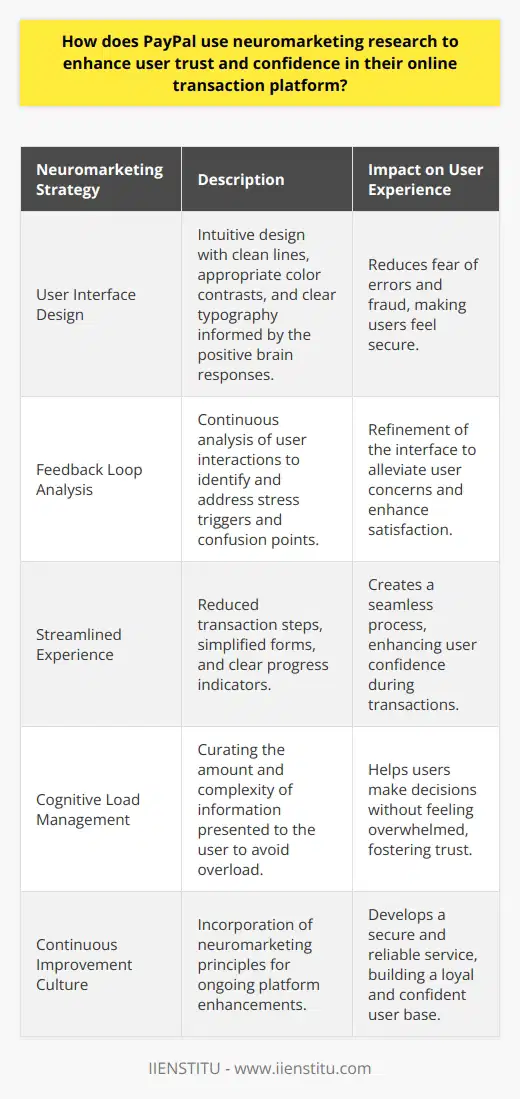
How does Disney use neuromarketing to optimize the emotional impact and appeal of their marketing campaigns?
Understanding Neuromarketing Strategies in Disney
Disney employs neuromarketing techniques to maximize the emotional resonance and allure of its marketing material. The key foundation of these techniques lies in understanding and leveraging human cognitive processes to influence consumer behavior.
Emotional Triggers
Disney marketers use story-telling as a proven method to evoke emotions since stories resonate with people's experiences. By creating memorable narratives, Disney elicits viewer emotions that compel them towards desired actions, thereby significantly boosting campaign efficacy.
Sense Stimulation
Neuromarketing at Disney also involves the strategic use of colors and sounds. These sensory stimulants play a critical role in conveying specific messages and generating emotional responses. For example, bright colors often suggest exuberance and joy, while soothing music fosters relaxation and tranquillity.
Character Connection
The company enhances its emotional appeal by building a deep connection between viewers and Disney characters. Fans' attachment to characters like Mickey Mouse and Elsa drive merchandise purchases, leveraging the emotional bond created through these characters.
Memory Implanted Marketing
Disney also leverages the psychological phenomenon of nostalgia. By reviving past successful content or characters, Disney stirs fond memories among consumers, making them receptive to new related content or merchandise.
Consumer Behavior Analysis
Through neuromarketing, Disney relies heavily on analyzing consumer behavior. Through data collected from various sources, Disney is able to make informed decisions about campaign messages and delivery methods that will evoke the best emotional response and product engagement.
In conclusion, Disney's use of neuromarketing, facilitates precise targeting, creating campaigns that resonate emotionally with audience members. This approach capitalizes on emotional appeal, a dominant driver of consumer behavior, to optimize the success of marketing campaigns.
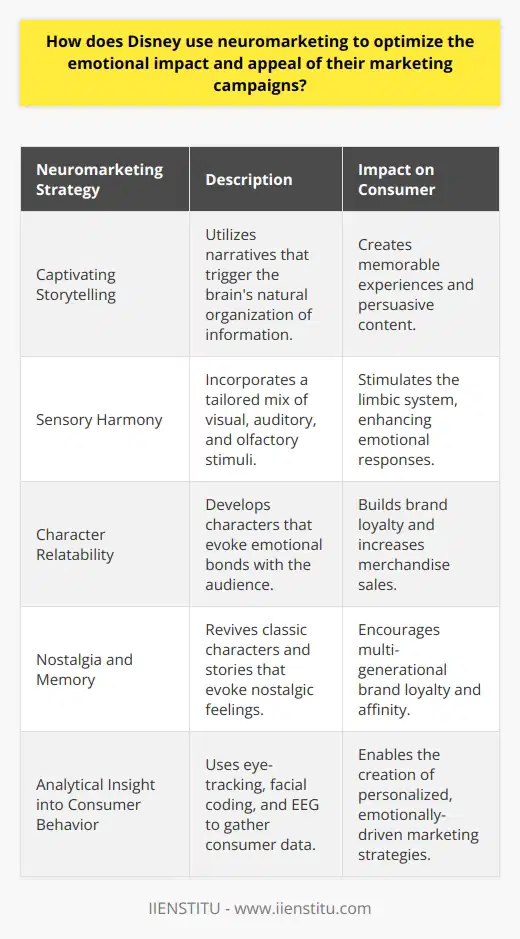
Which companies successfully employ neuroscience research to enhance their understanding of consumer preferences and decision-making processes?
Neuroscience Applications in Corporate World
A company successfully applying neuroscience is Nielsen. They use techniques like electroencephalography (EEG) for understanding consumer preferences. EEG measurements inform about brain patterns, thereby, shedding light on preference development.
Utilizing Neuroscience for Market Research
The advertising agency, Campbell Ewald, uses neuroscience to understand consumer decision-making processes. They employ tools such as facial coding to comprehend emotional responses. This data aids in enhancing future campaigns by aligning them more closely with consumer emotions.
Leveraging Brain Imaging in Marketing
Google also utilizes neuroscience for understanding how consumers respond to advertisements. Their usage of functional Magnetic Resonance Imaging (fMRI) reveals areas of brain activation during advertising consumption. This gives insights about what elements stimulate consumer interest and can guide ad development.
Incorporating Empathy in Design
IKEA uses neuroscience to understand the emotional connections consumers form with objects. They have 'empathic design teams' studying neural responses to new products. This helps them to ‘humanize’ designs and increase product competitiveness by generating a deeper emotive appeal.
Predicting Consumer Choices through Neuroscience
Lastly, Frito-Lay uses neuroscience to predict consumer choices. Using EEG data, they discovered that consumers responded more positively to the less crunchy variant of potato chips. This enabled Frito-Lay to tailor their manufacturing based on precise consumer preferences.
In conclusion, companies like Nielsen, Campbell Ewald, Google, IKEA, and Frito-Lay employ neuroscience to enhance their understanding of consumer preferences and decision-making processes. They use a range of tools from EEG to fMRI to effectively employ neuroscience in informing their marketing, advertising, product development, and manufacturing strategies.

How does Apple utilize neuromarketing insights to design user-friendly interfaces and create an emotional connection with their customers?
Understanding Consumer Behavior
Apple taps into neuromarketing, the science of understanding consumer behavior to enhance the design of its user interfaces. This innovative approach enables the tech giant to delve into the subconscious mind of the user, exploring cognitive biases that influence decision-making.
Creating User-Friendly Interfaces
Neuromarketing insights contribute to the design of intuitive and user-friendly interfaces. By employing elements that appeal to the brain's processing capabilities, Apple ensures simplicity and ease of use. Consequently, it reduces cognitive load, enhancing the overall user experience.
Establishing Emotional Connection
Furthermore, Apple leverages neuromarketing to create an emotional connection with their customers. It does this by integrating familiar designs and functionality. This familiarity induces feelings of trust and comfort, forging a bond between Apple and its consumers.
Value of Positive Emotions
The use of colors, sounds and haptics also play a significant role in Apple’s strategy. These sensory cues elicit positive emotions, imprinting a lasting impression on consumers. The immense satisfaction derived from using Apple devices often leads to a stronger customer loyalty.
Adopting Minimalist Design
When designing its products and advertising campaigns, Apple adopts a minimalist design. This strategy aligns with the brain’s preference for simplicity, thereby making information processing easier. The sheer simplicity fostered within its user interfaces creates an enriching user experience, hence fostering a profound customer bond.
In conclusion, Apple successfully leverages neuromarketing insights to fortify its connection with consumers. It continuously explores new ways to understand what truly inspires customer loyalty, tailoring its strategies to meet these needs. Therefore, it's evident that neuromarketing has significantly contributed to Apple's distinctive positioning in the tech industry, making it a beacon of user-focused design.
